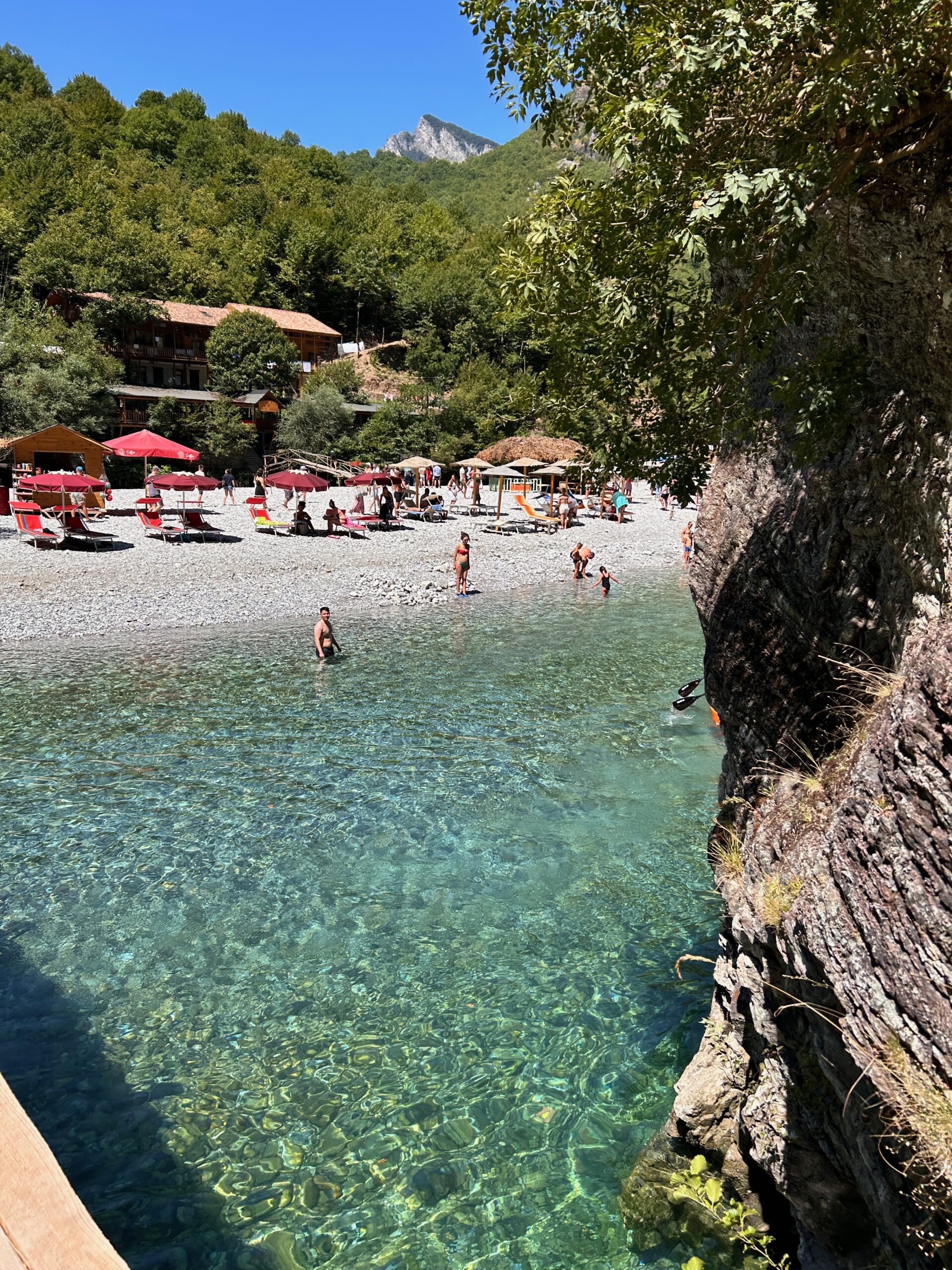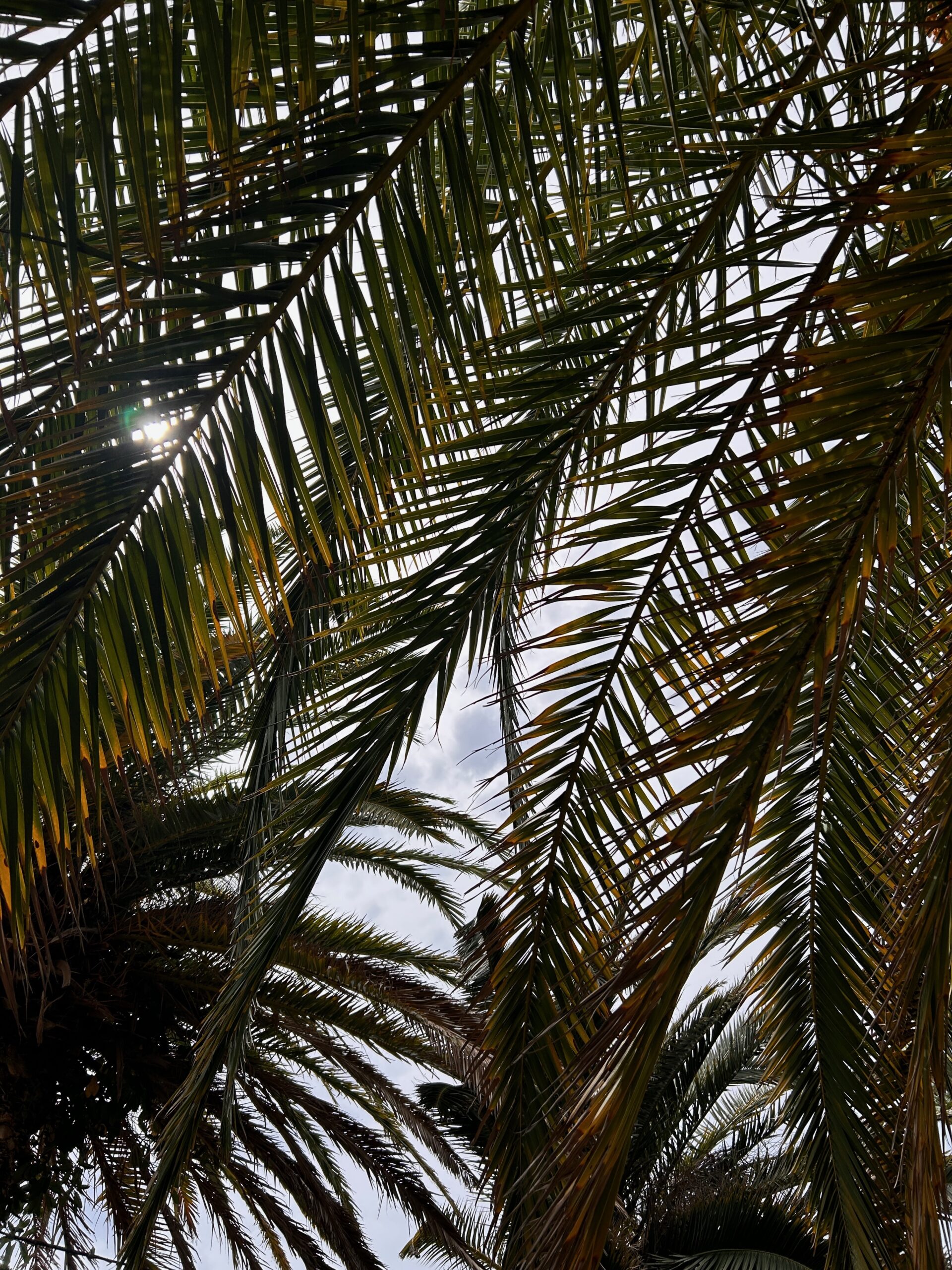The Balkans are a hidden gem of Europe: with their diverse cultures, stunning landscapes, and rich history, they offer an unforgettable adventure for any traveler. After years of dreaming about exploring this captivating region, I finally embarked on the ultimate Balkans road trip through Croatia, Bosnia, Montenegro, and Albania! I crafted a 19-day journey that encompasses both iconic destinations and off-the-beaten-path treasures, from the walled city of Dubrovnik to the pristine beaches of the Albanian Riviera. As an avid explorer, I crave authenticity and meaningful encounters. I’m always up for a bit of adventure and love delving into the local culture and history!
Our goal was to discover new places each day while allowing for ample relaxation. We planned to visit cities like Split and Dubrovnik, explore waterfalls in Bosnia, stop by coastal towns of Montenegro such as Budva and Kotor, and uncover hidden gems on Skadar Lake, along the Neretva River, and beyond. These lesser-known spots turned out to be the highlights of our journey. Ultimately, we wanted to conclude our Balkans road trip in the mountains of Albania, where we could unwind and enjoy calm and nature.
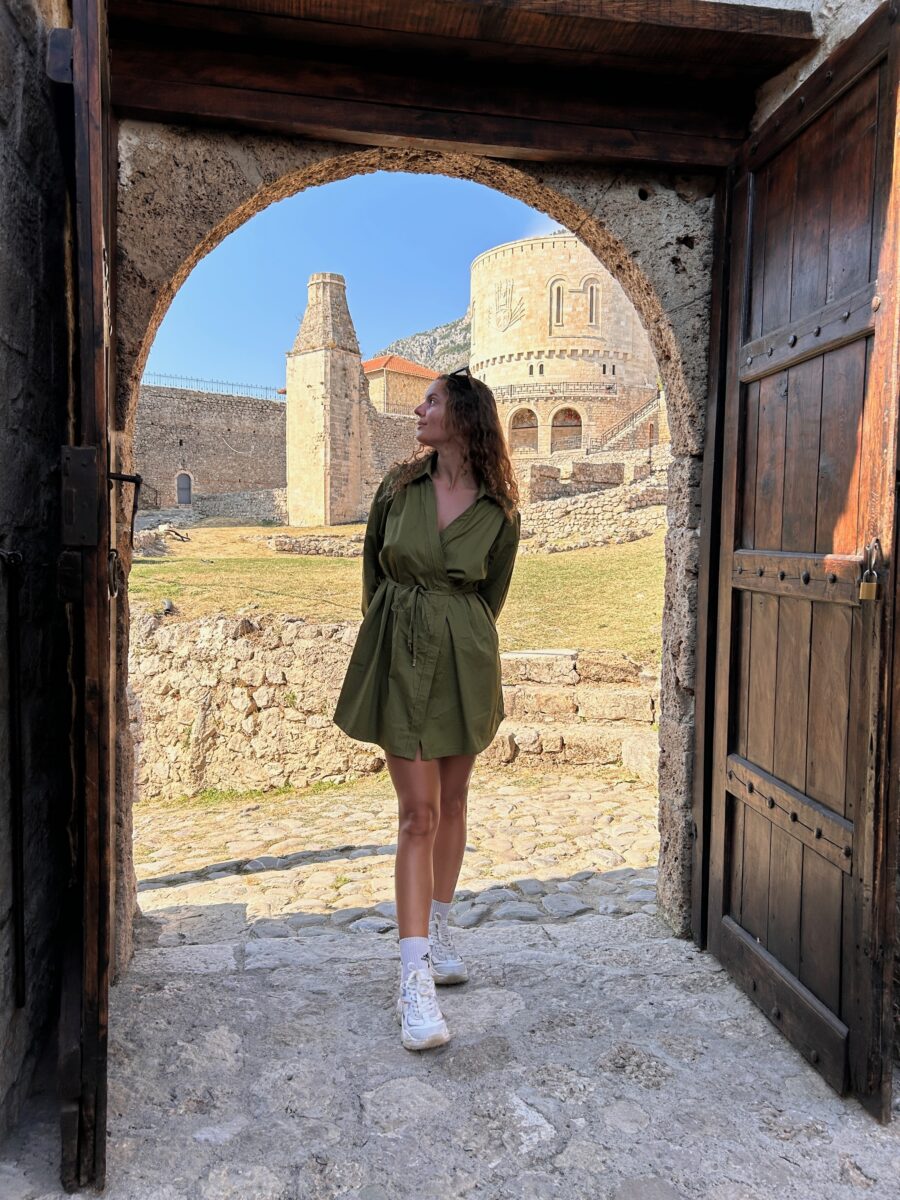
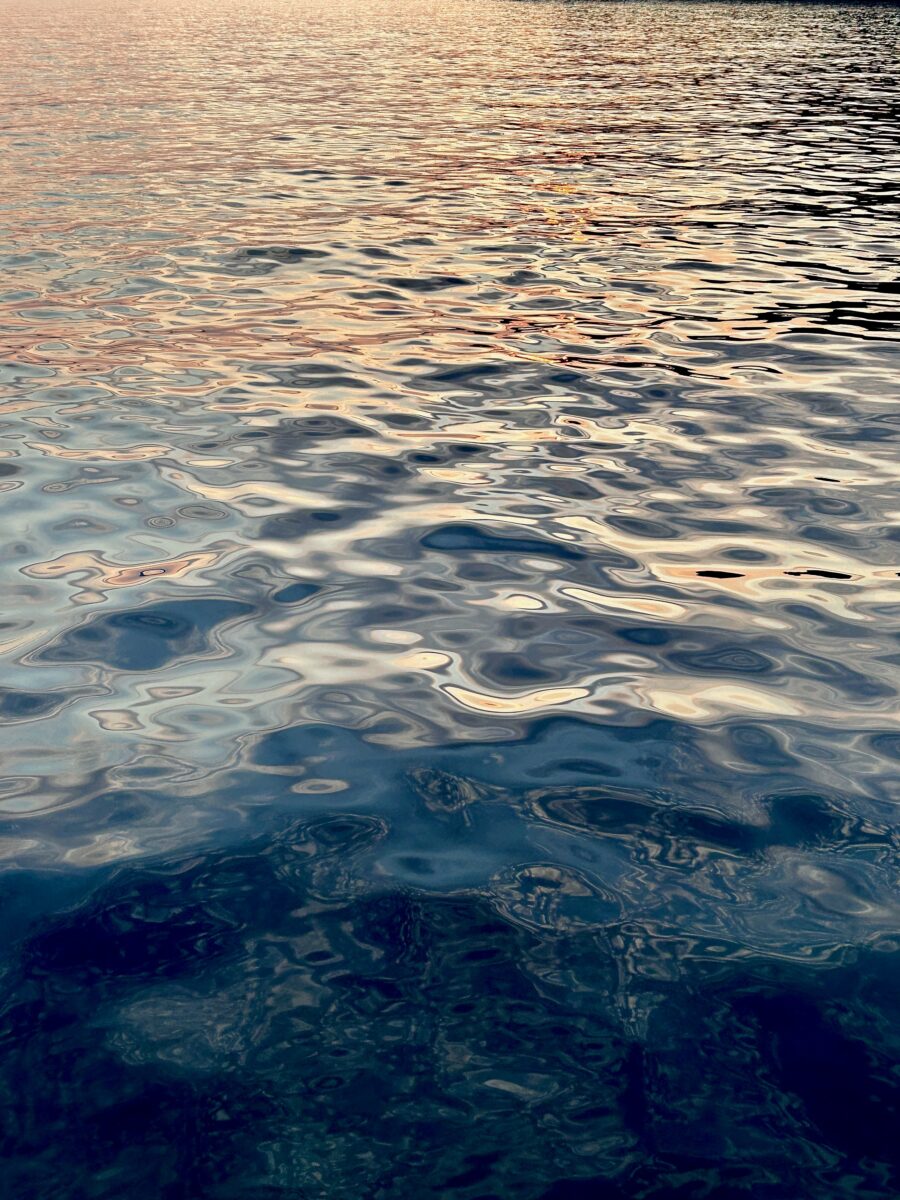
Table of Contents
Logistics and budget
We rented a car to move around freely in the Balkans. The road infrastructure and public transport varies widely across the region, so we decided to go for the most comfortable option. We picked up our car at Split airport and returned it at Tirana airport. We stayed between 1-5 nights in different spots across the coast and mountains.
- a total of 15-19 days
- budget of 3000-5000 EUR for two people, including car rental, accommodation, and food
- 4 countries: Croatia, Bosnia and Herzegovina, Montenegro, and Albania
- most places accept euros (preferably cash)
You can compare the price of flights and car rentals on skyscanner.com. I use it religiously. Most car rental companies have international offices so it is totally possible to pick up a car in one country and drop it in another, although you will most likely have to pay an extra fee for that service (200-500EUR). In total, for a two-week car rental, I recommend to plan a budget between 1000-1500 EUR and book as early as possible. We paid around 500EUR per person for our outbound and inbound flights, including one checked-in luggage of 30kg.
For accommodation, I recommend booking.com. It rewards your expenses with discounts. For two people for two weeks, we paid about 1800EUR, with a wide variety of places ranging from beach-front hotels to B&B rooms in a 100-people village.
In this itinerary, I mention the visits, restaurants, and hotels which we genuinely enjoyed and thought were worth sharing. This way, you get only quality recommendations. None of them are based on partnership and we paid for everything ourselves. I make small commissions for any reservation you make using the links below, without changing the price for you. If this sounds like a guide you’d follow, keep reading for a full guide to the mesmerising region of the Balkans!
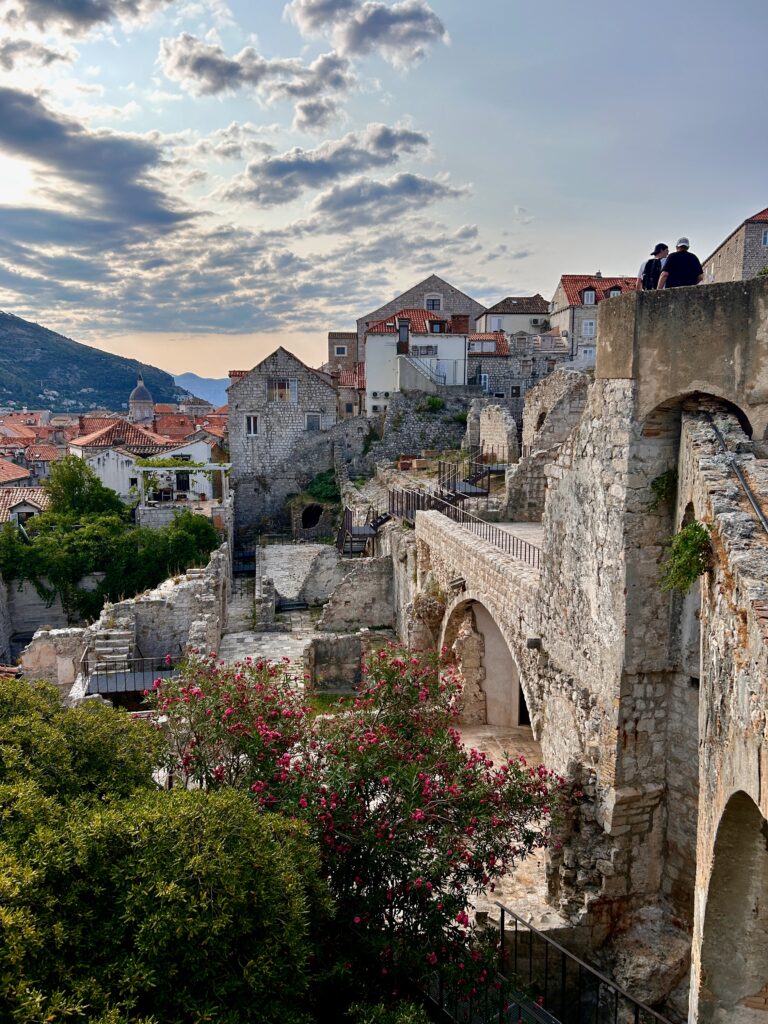
Day 1: Trogir (Croatia)
We started our Balkans road trip in Trogir, of which the old city is a UNESCO World Heritage site. It is a small island town on the Dalmatian coast of Croatia, linked to the mainland by bridges. It feels like a living museum! Its winding streets and well-preserved buildings showcase a beautiful mix of medieval and Renaissance architecture.
Here are some highlights in Trogir:
- Explore the Cathedral of St. Lawrence with its intricately carved entrance.
- Climb the ancient Kamerlengo Fortress for panoramic sea views.
- Wander through the narrow alleys and discover hidden courtyards.
- Visit the lively Green Market in the morning for a taste of local life.
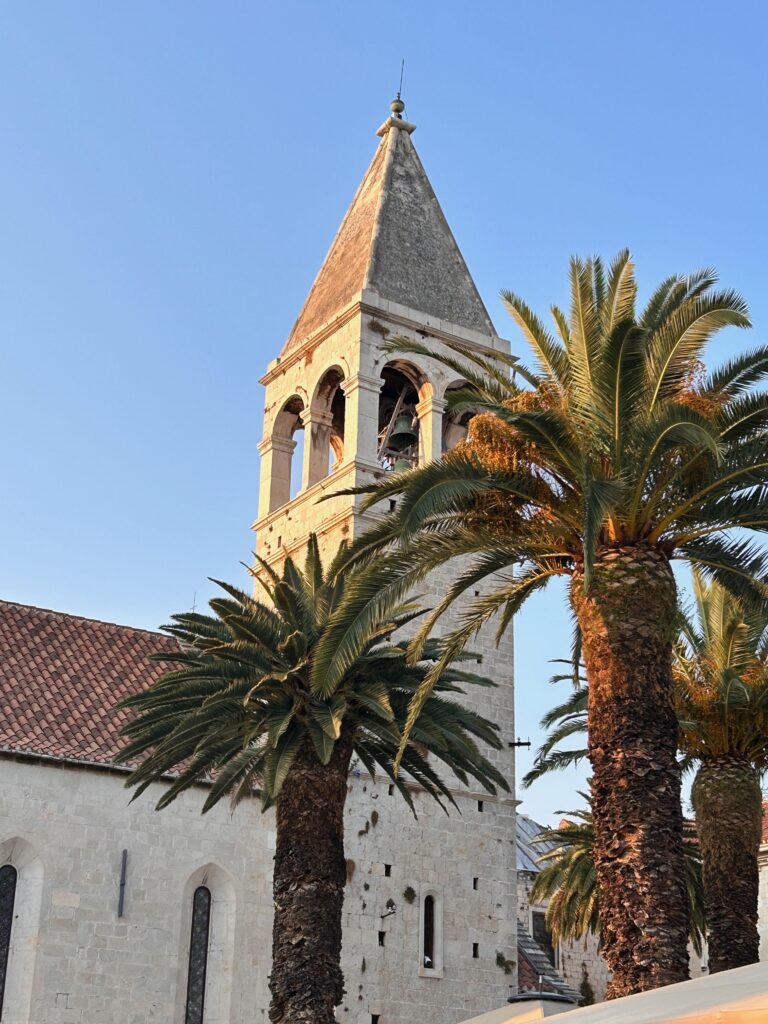
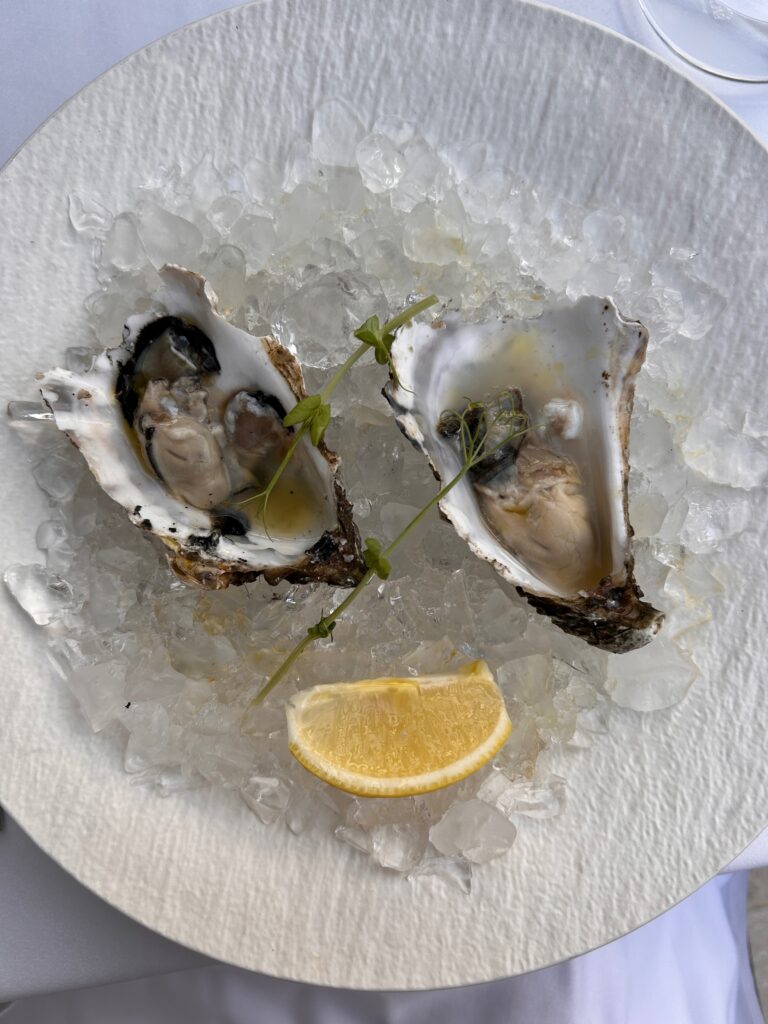
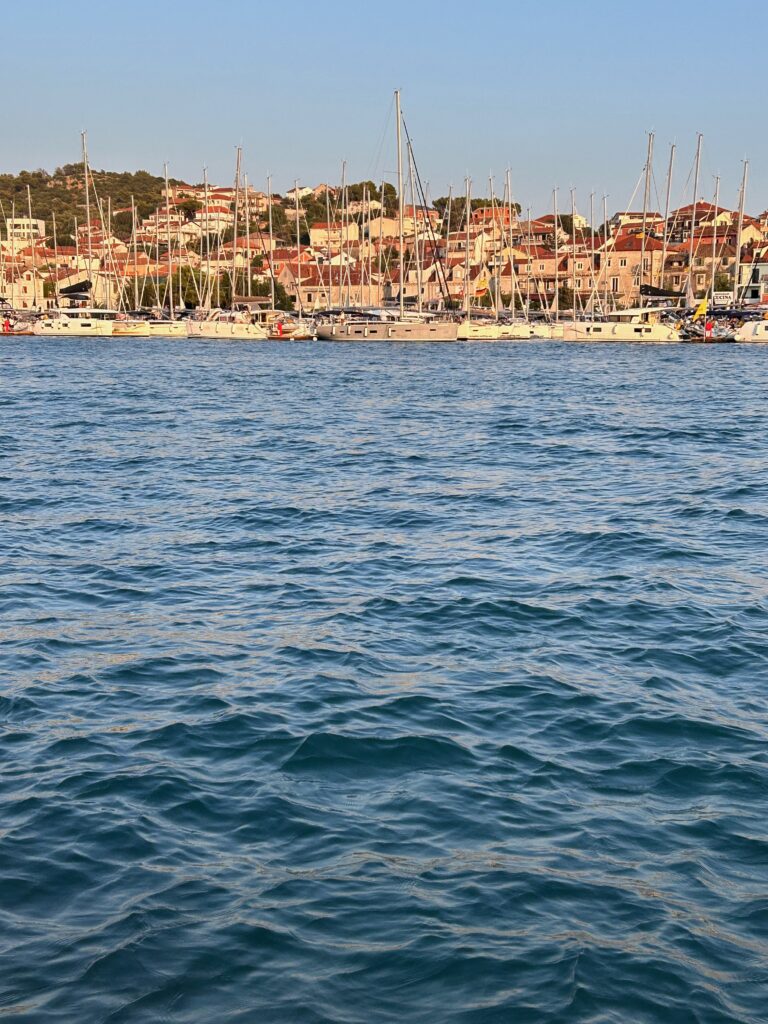
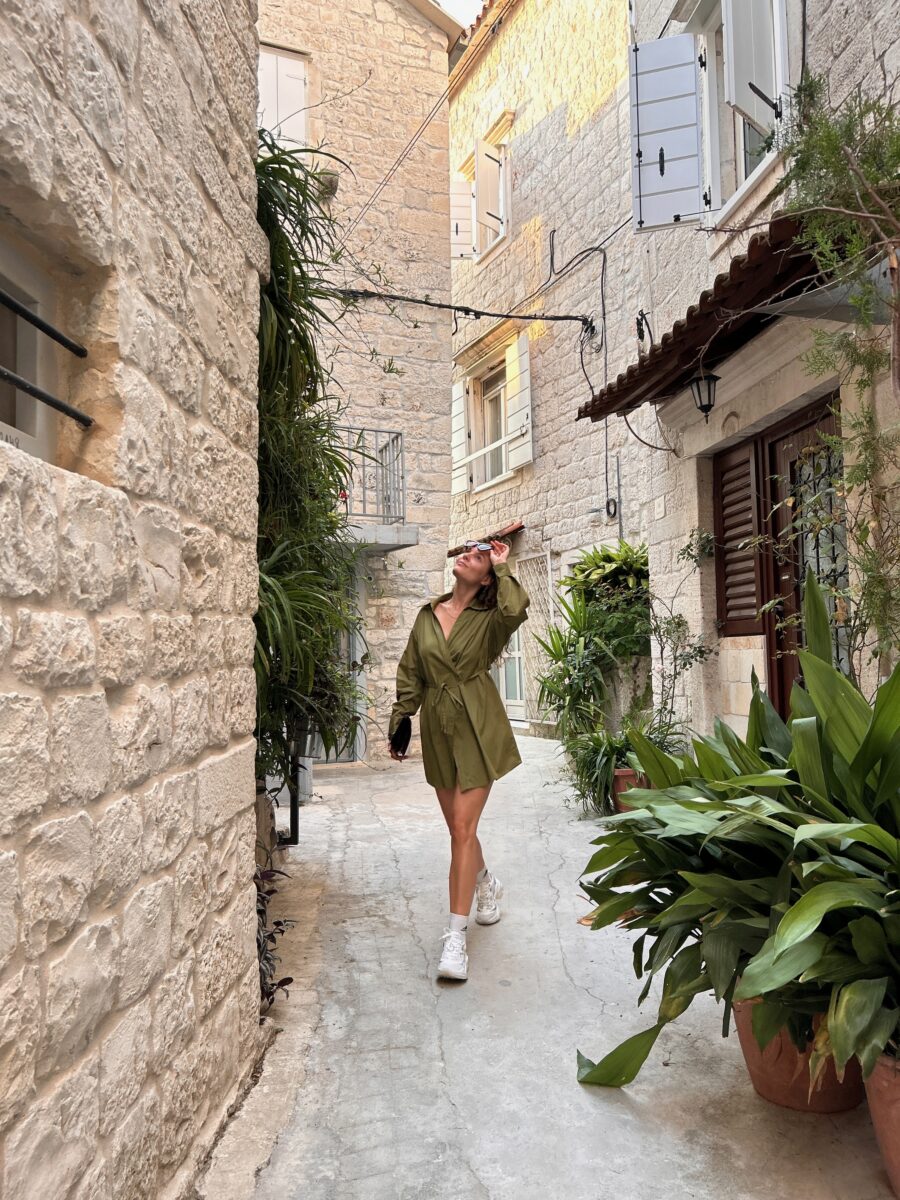
For dining, we recommend finding small restaurants in the alleyways of the old city, or venture in the countryside around. Trogir is quite touristic and popular with families and couples, making it a busy hotspot. This means that good restaurants are rare and usually expensive. We paid on average 30-40EUR per person per meal. We stayed at Kadena Studio Apartments, which was perfectly located only 5-min walk away from the centre of the old town, but tucked away in a tranquil alley with a terrace and scenic views.
Day 2: Krka National Park & Dalmatian Coast (Croatia)
Krka Waterfalls
We visited Krka Waterfalls in the morning, arriving on site around 10:00. The biggest waterfall, Skradinski Buk, was amazing. Water crashes down 45 meters into a clear pool, with beautiful pathways across nature with colourful fish, dragonflies, and birds. Wear good shoes that can get wet, as the walkways can be slippery. Bring a swimsuit if you want to swim near the falls (only in certain areas).
The park has easy trails with signs about plants and animals. Plan to spend at least 3-4 hours here. You can buy food, but bringing a picnic is cheaper and fun. There are boat tours too, which give you a different view of the falls. Highly recommended if you stay near Split as it’s only 40 min away by car or by bus!
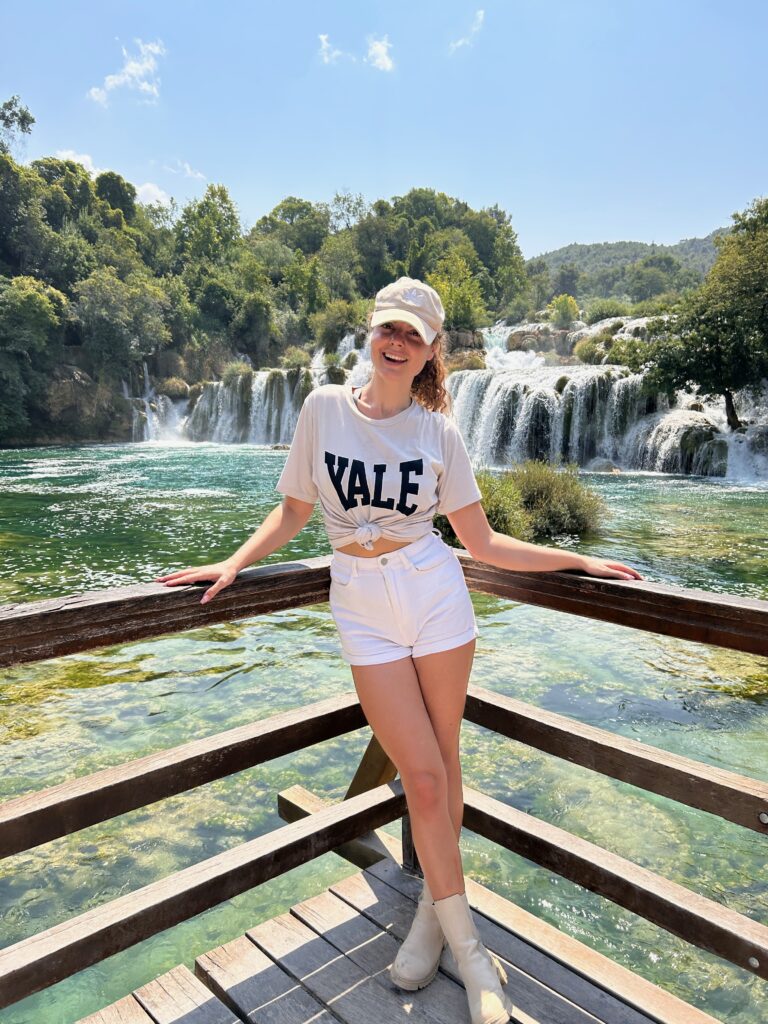
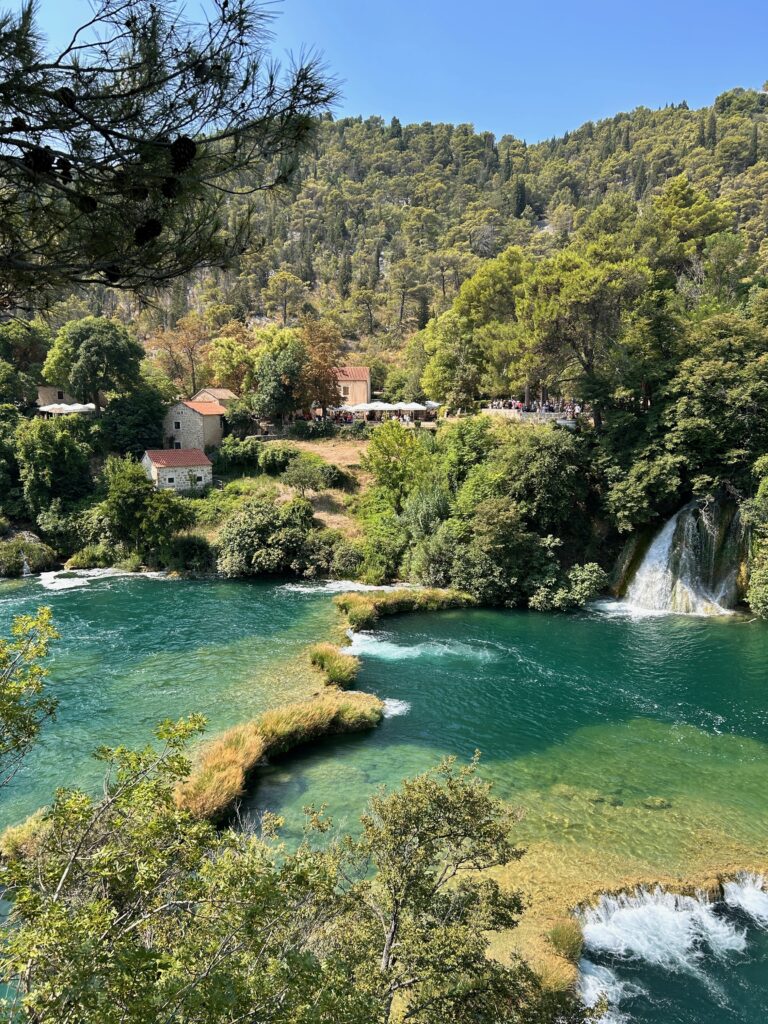
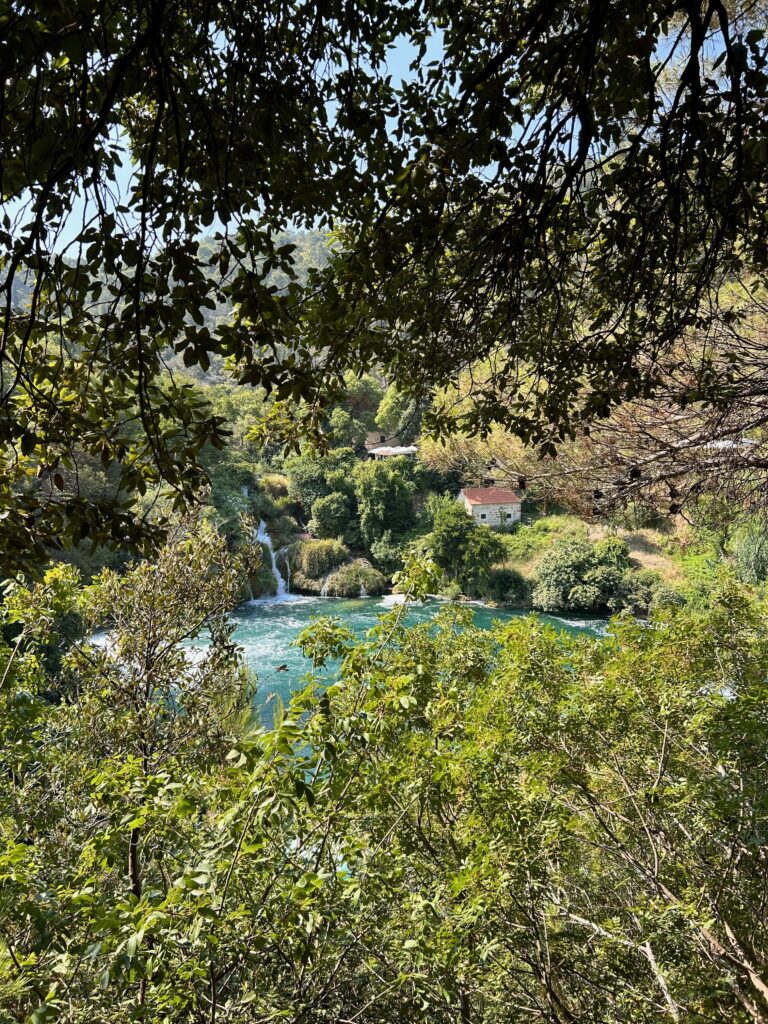
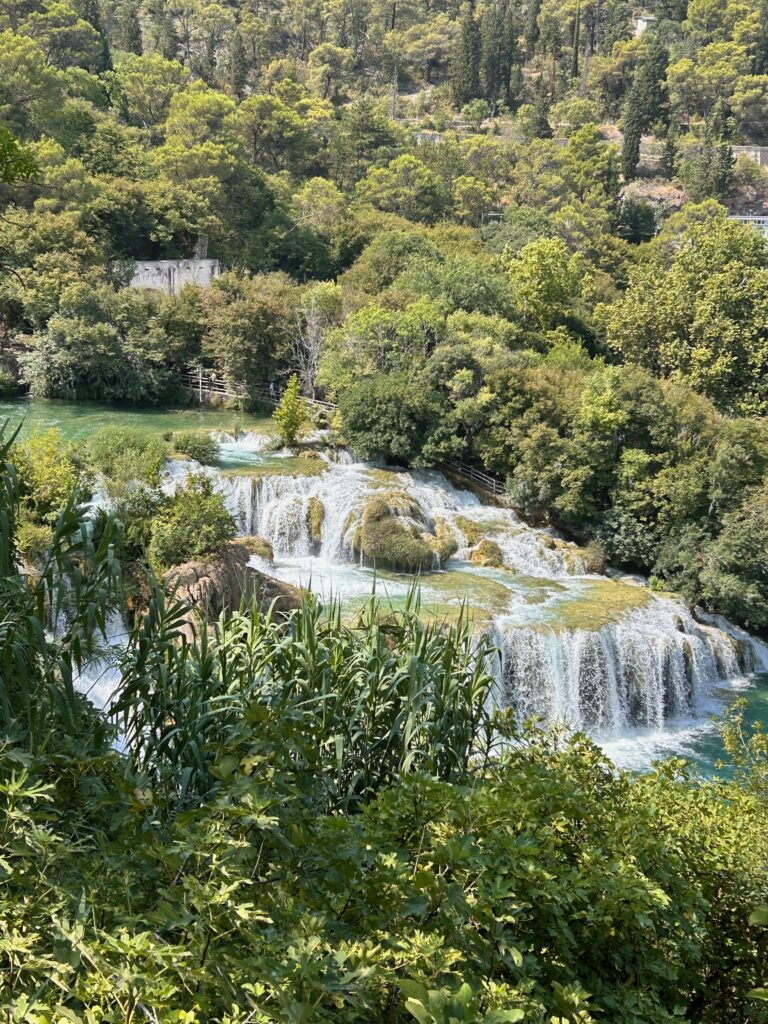
Rogoznica and Kanica
On our way back from Krka National Park, we wanted to explore nearby beaches before heading to Trogir. We discovered the lovely coastal town of Rogoznica, where we found a very nice sandy beach as well as a long rocky beach with many stone platforms where people were enjoying the sunshine and turquoise waters… a dream!
We stopped by Ancora, a seemingly random beach bar, which served us delicious salads with veggies from the garden and freshly baked bread worth a Michelin star. We absolutely loved it. They also served pizza and sandwiches. We then explored the small town of Kanica, especially its secluded Žaline Beach, which was an absolute wonder.
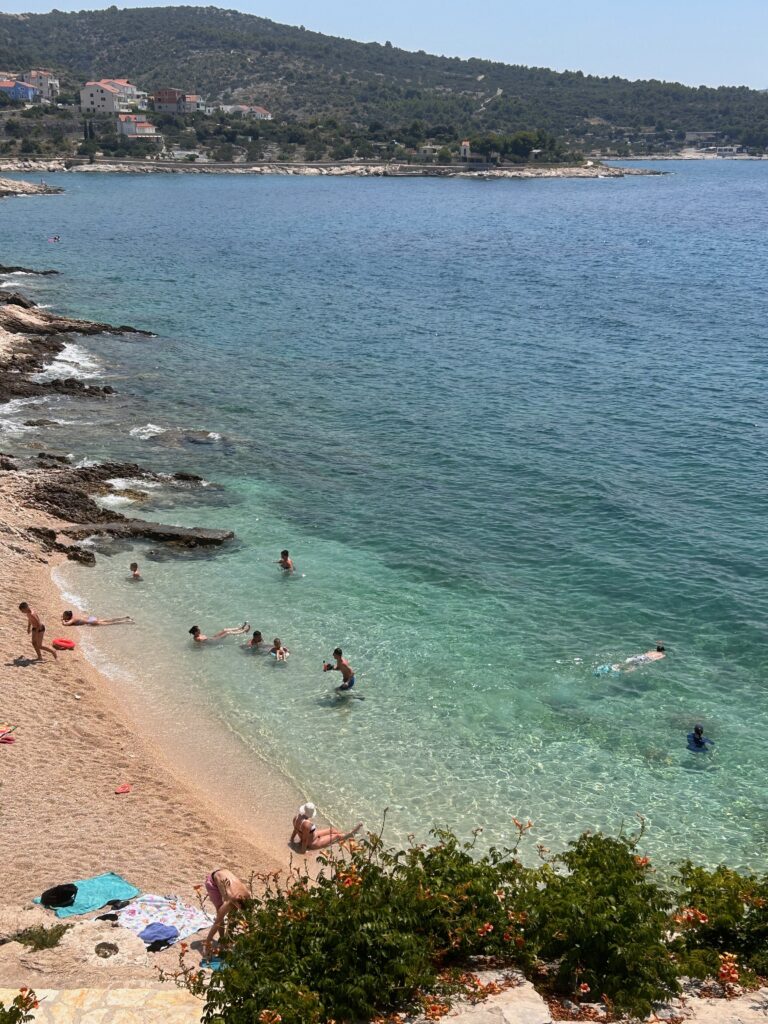
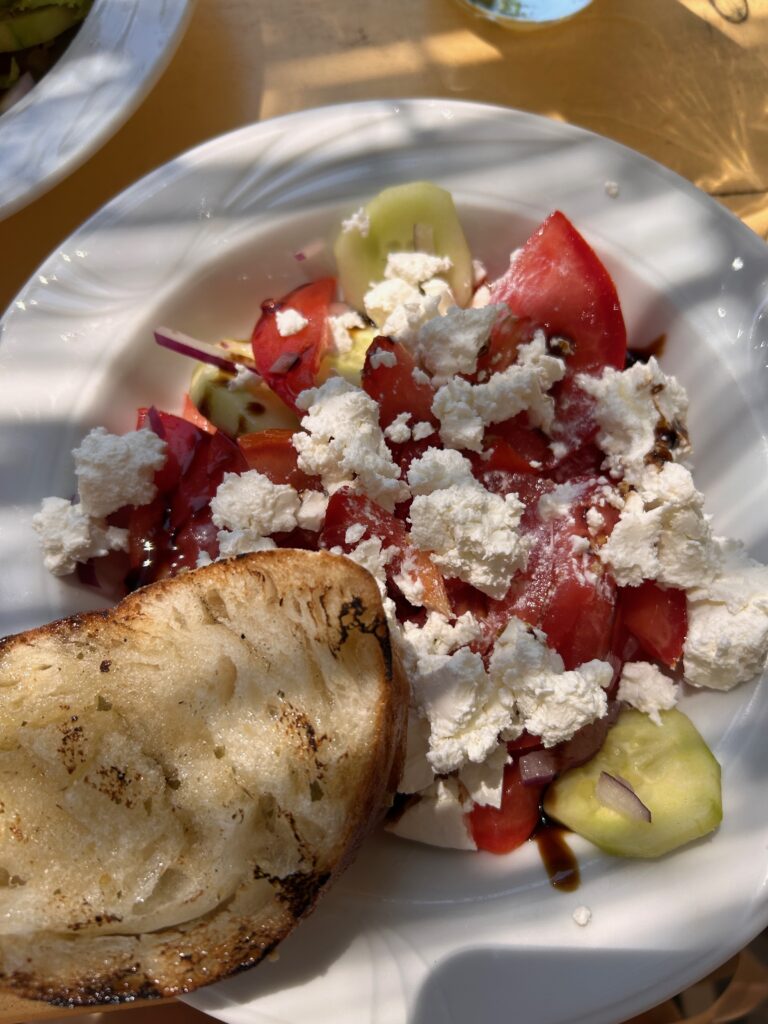
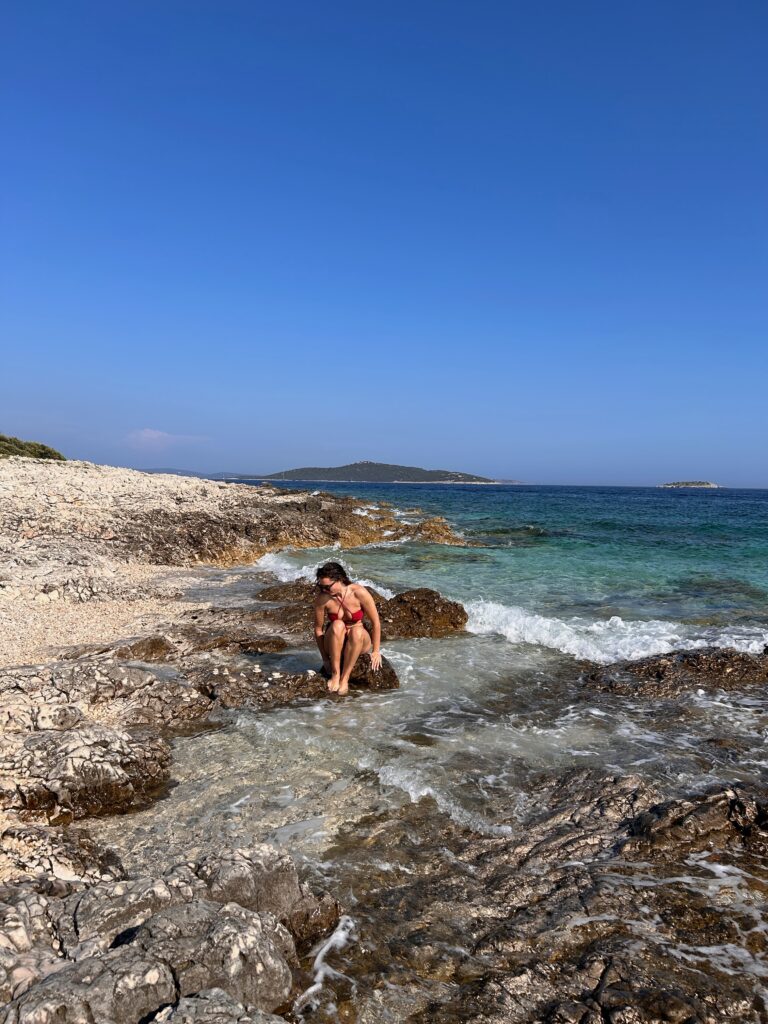
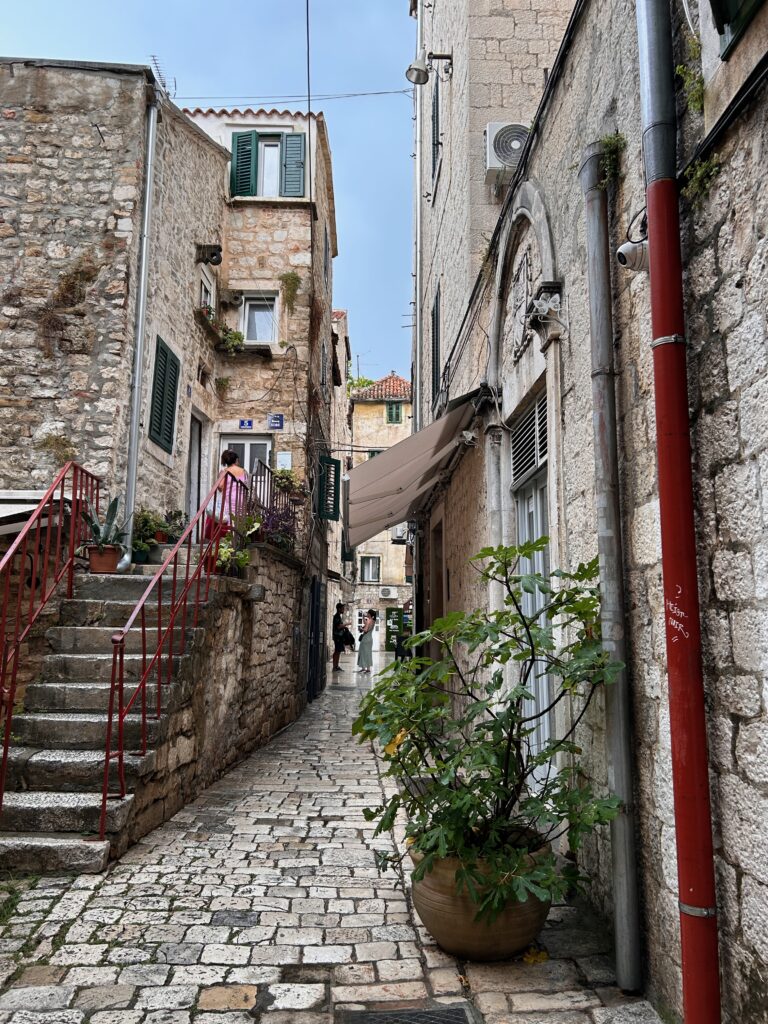
Day 3: Split (Croatia)
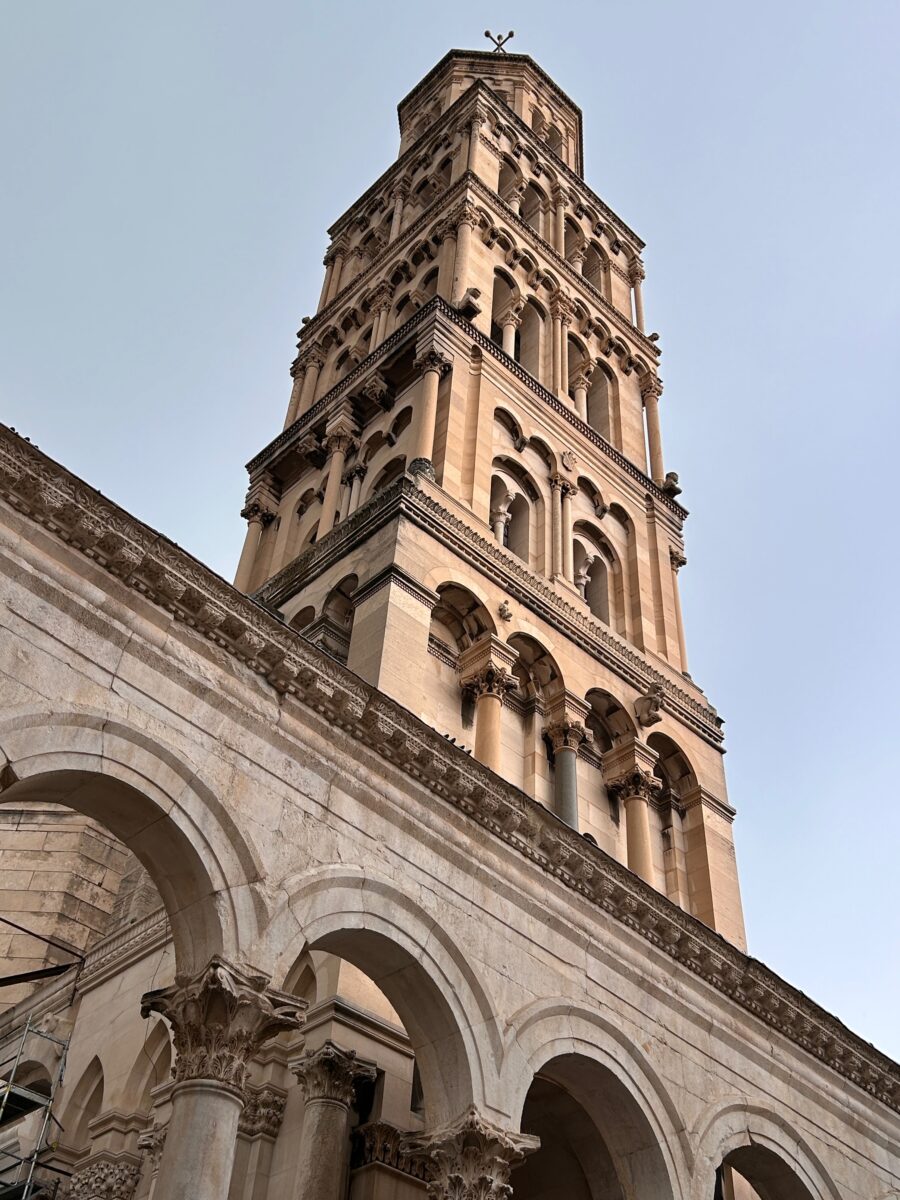
Walking through Split’s old city is like stepping back in time. The heart of it is Diocletian’s Palace, built by a Roman emperor over 1,700 years ago. Today, it’s not just ruins – people live and work in the old buildings, making it a lively place. The narrow streets are fun to explore. You’ll find little shops, cafes, and restaurants tucked away in corners. Don’t miss the Porta Aurea and the main square, called the Peristyle. It has impressive columns and sometimes hosts concerts.
For a great view, climb the bell tower of the Cathedral of Saint Domnius. It’s a bit of a workout, but the sight of the red roofs and the sea beyond is worth it. If you like markets, check out the Green Market just outside the palace walls. It’s full of fresh fruits, vegetables, and local products. We bought water shoes and a snorkeling kit there.
In Split, we hopped onto a ferry to continue our journey on the island of Hvar. The ride cost about 60EUR (with a car) and lasted about 45 min.
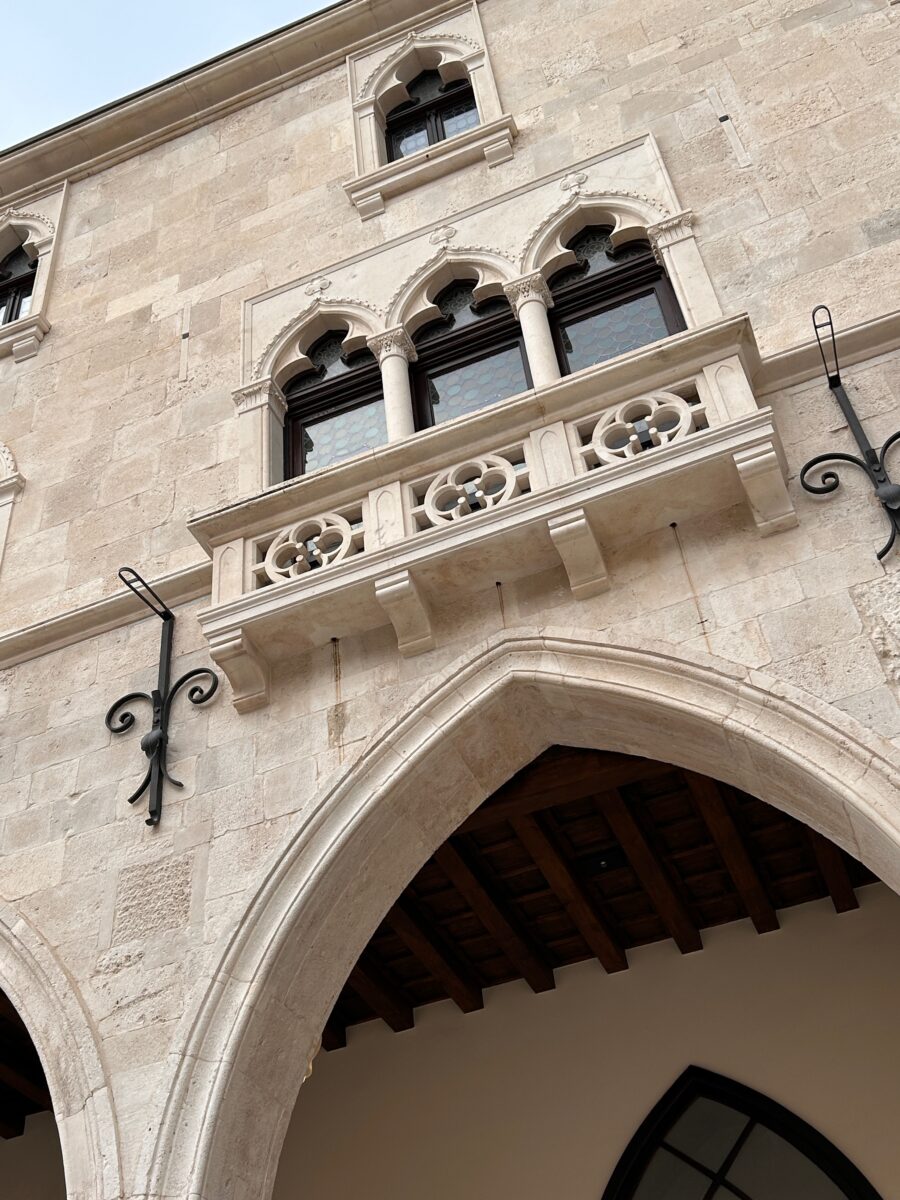
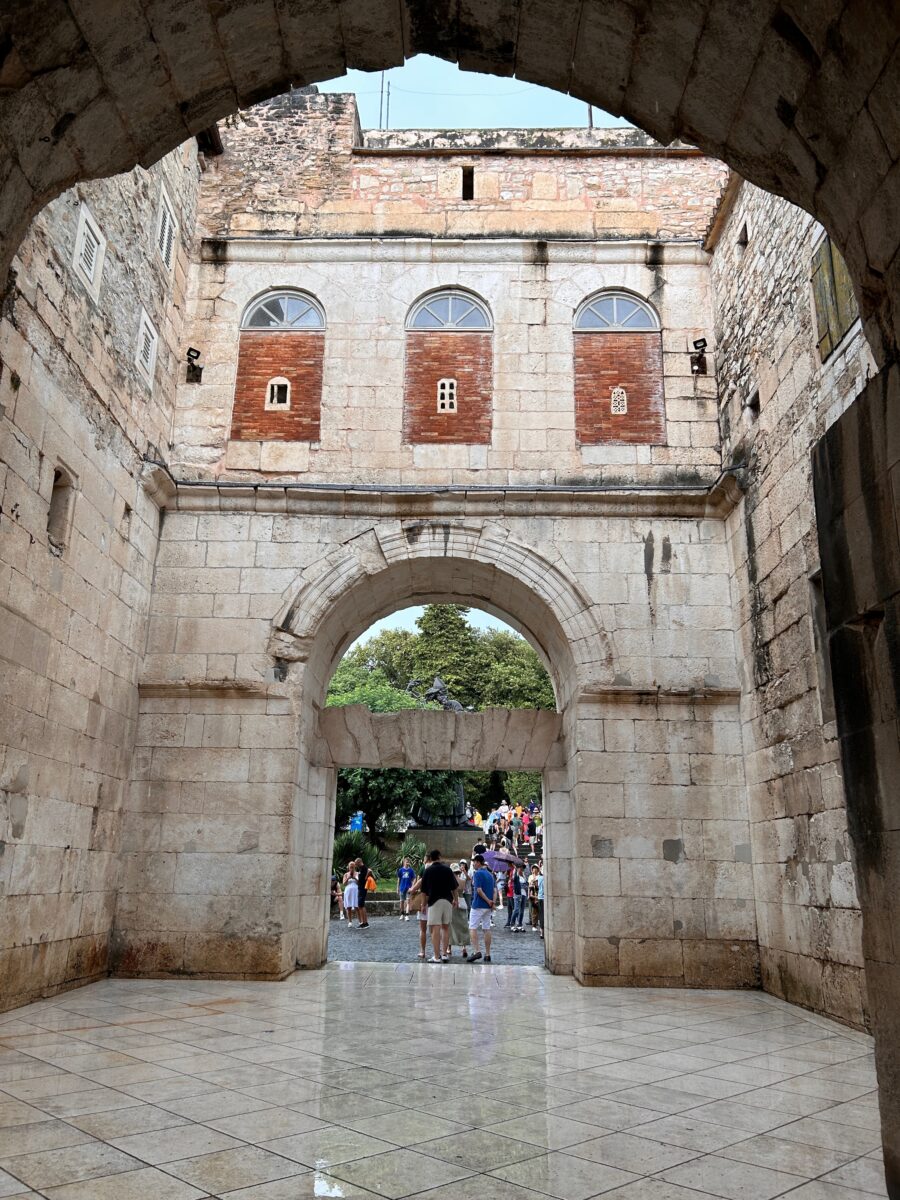
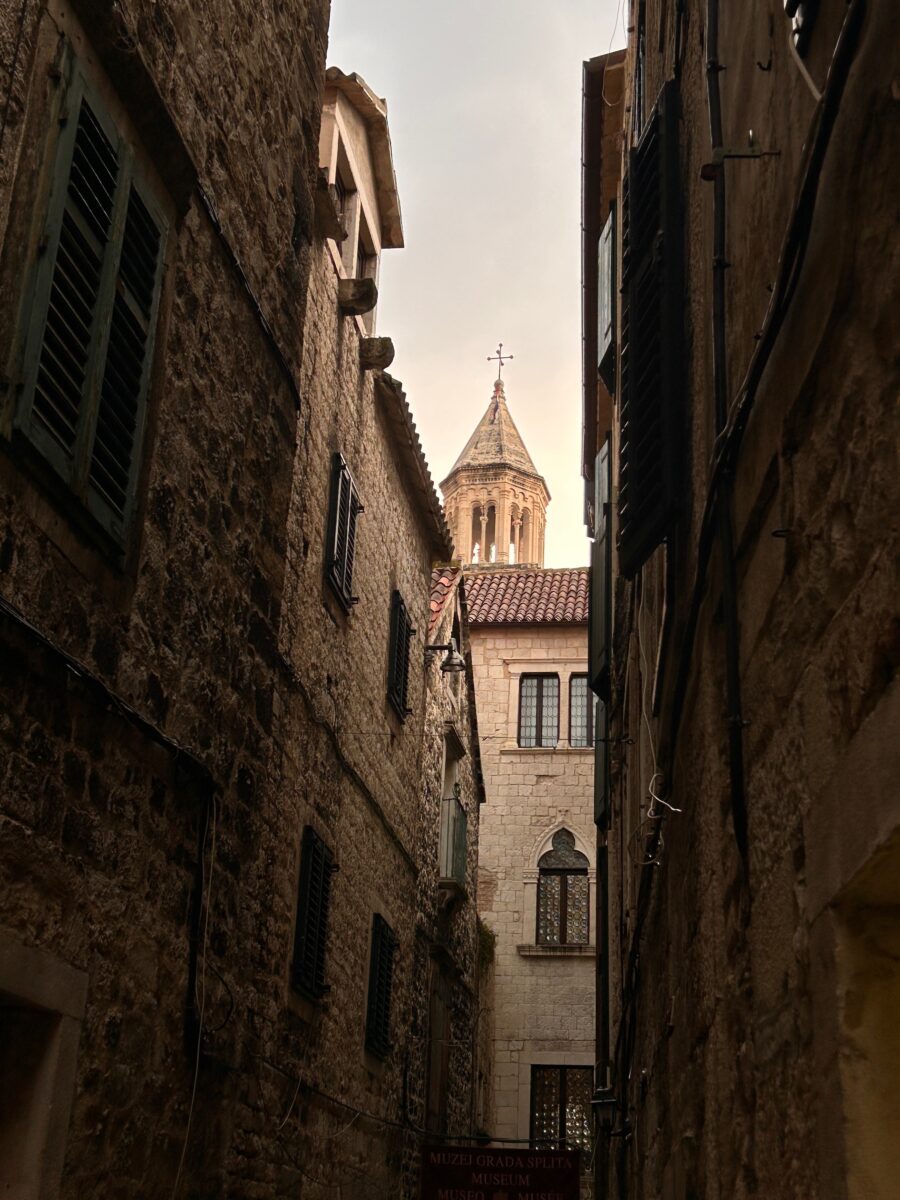
Day 4-5: Hvar Island (Croatia)
Hvar Island is a popular destination in Croatia, especially among young people. It’s the perfect destination to enjoy a bit of a party, luxurious hotels and restaurants, and strolling around the centre for local boutiques.
my top 5 places to visit in Hvar, Croatia:
1️⃣ Konoba Luviji Rooftop: a delicious authentic restaurant with unparalleled views over the town, hidden inside the small streets of its old city
2️⃣ Fortica Fortress: a must-see for panoramic views over the marina of Hvar as well as fantastic insights into medieval life on the island
3️⃣ Palmižana Island: accessible via a taxi boat, this small island is a hidden paradise for anyone loving luxury lifestyle in charming surroundings and turquoise waters
4️⃣ Dalmatino: a classic local restaurant with exceptional service and excellent wine in the centre of the old town – reservations highly recommended
5️⃣ Brusje: away from the crowds of Hvar’s old town, you’ll find a few mountain villages like Brusje that offer authentic food and crafts surrounded by lavender fields and magnificent views of the sea
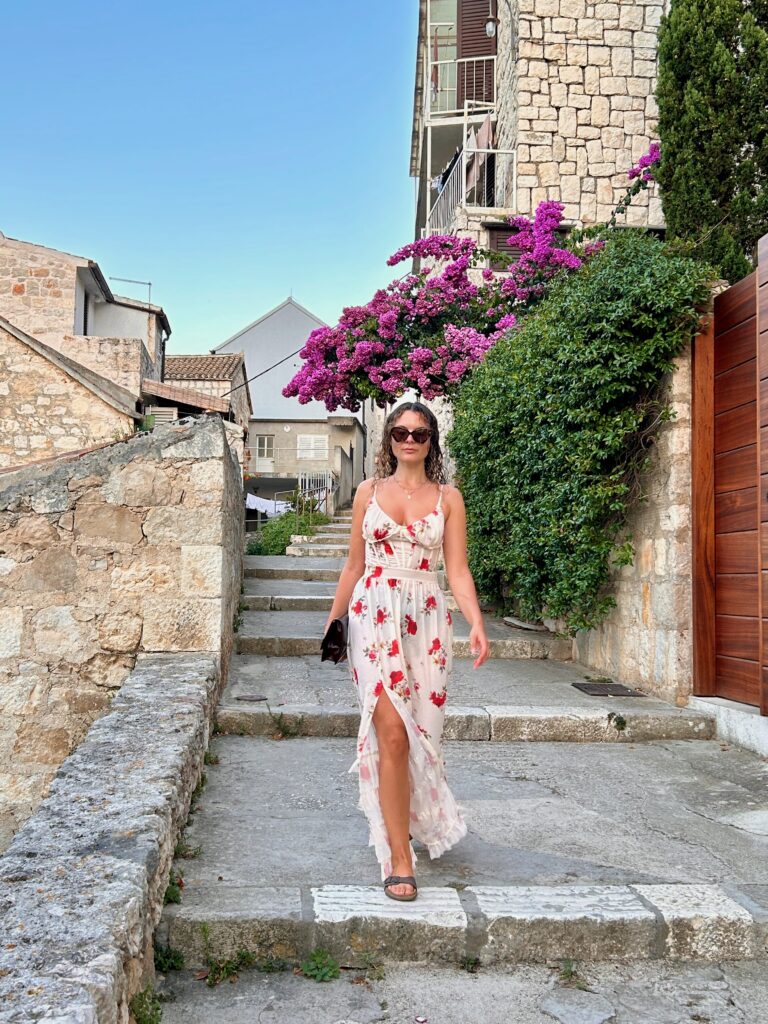
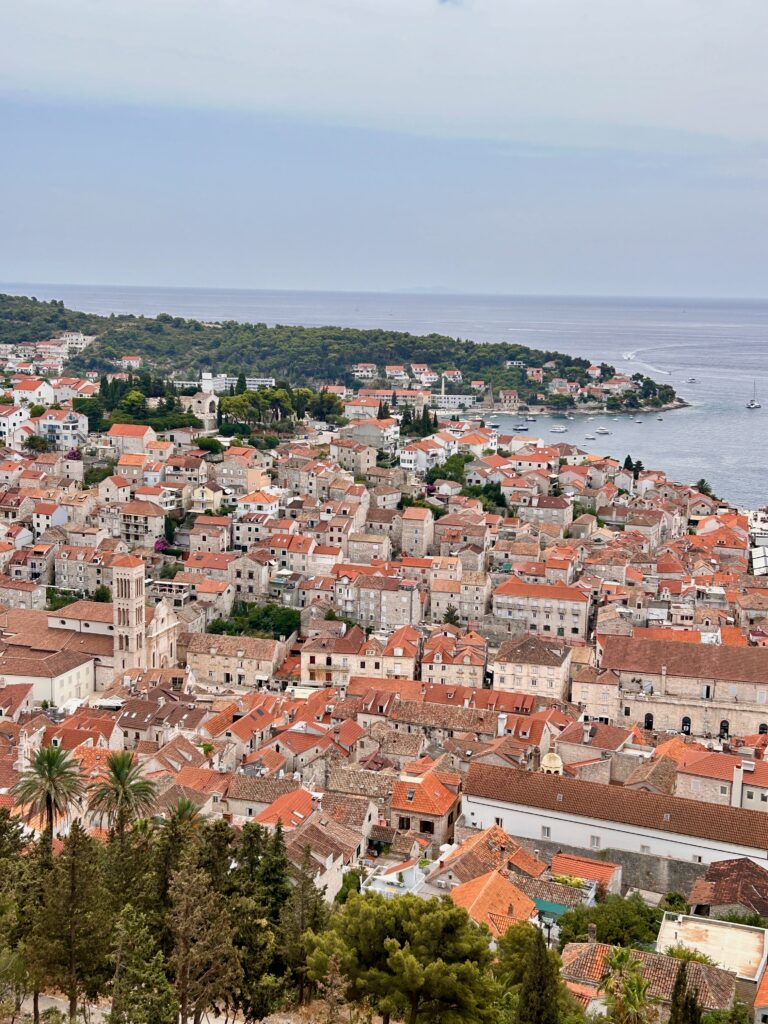
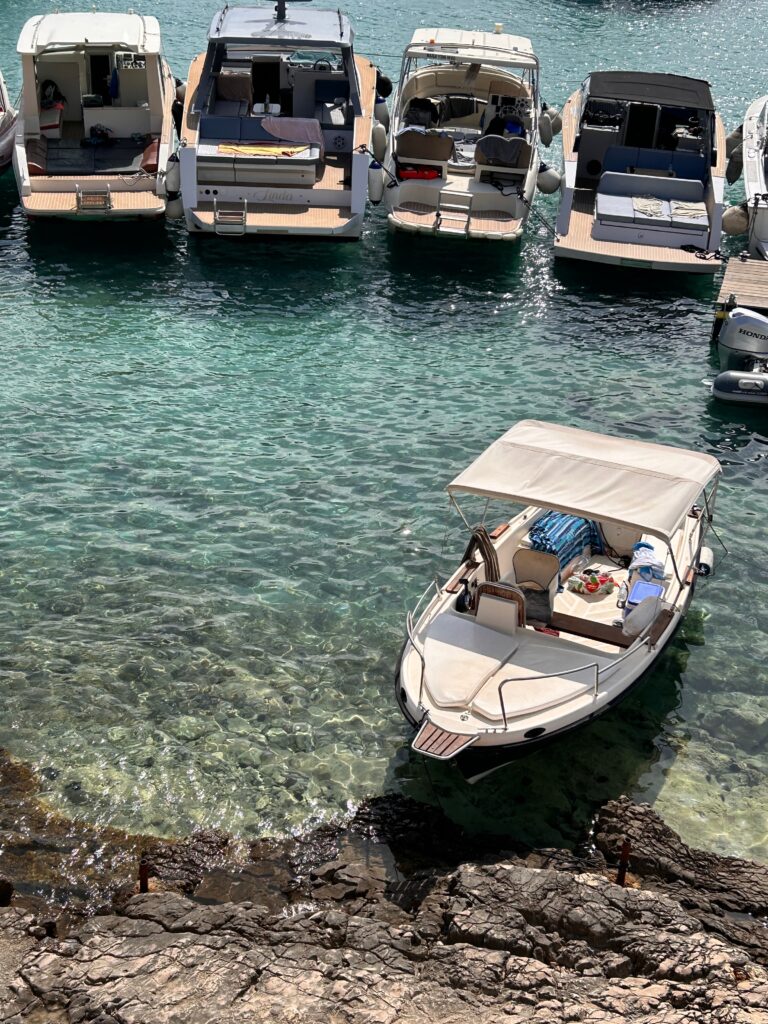
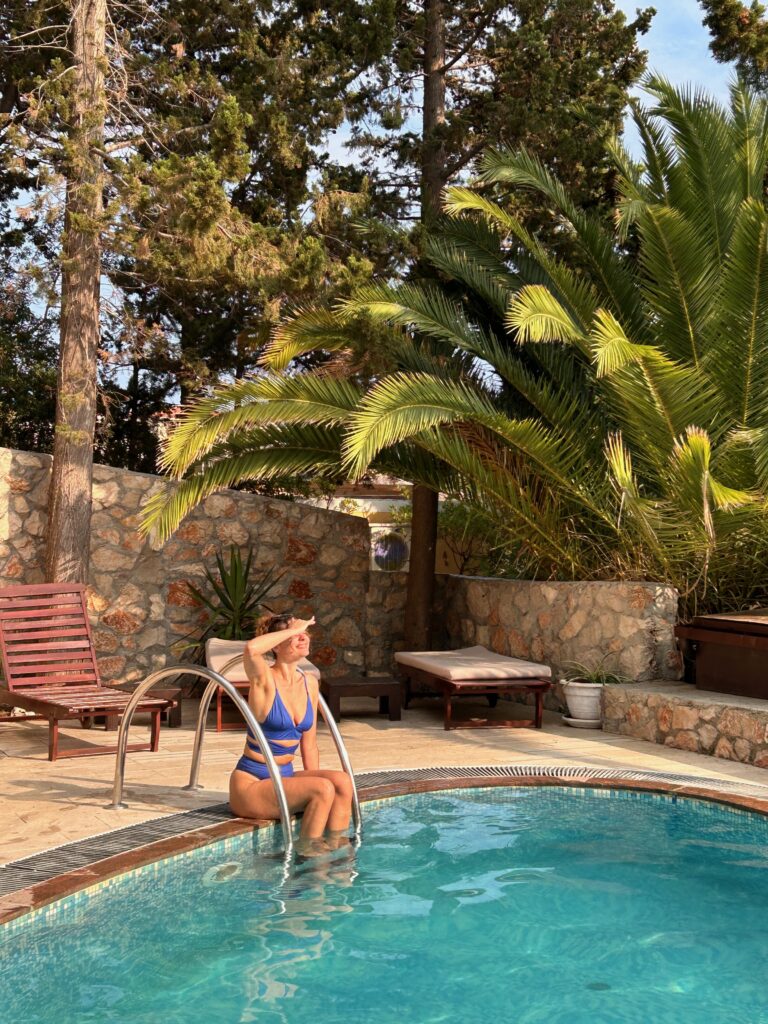
Hvar is rather expensive in terms of accommodation. For this reason, I recommend staying in a hotel off the beaten path, which will guarantee cheaper prices as well as tranquility away from the buzzing old town. We stayed at Hotel Podstine, which was wonderfully located with direct beachfront access.
Day 6-7: Ljubuski (Bosnia and Herzegovina)
The road from Hvar to Ljubuški in Bosnia is absolutely beautiful: you have to cross the entire island and hop on a ferry that takes about 20 min to cross onto the mainland. The 360 views from the top of the mountains were some of the most scenic I’ve ever seen… especially at sunset! Crossing the border between Croatia and Bosnia took us just 5 minutes.
Once arrived in Ljubuśki, we stayed at a local bed and breakfast next to a river, which was fabulous: Guest House Green River. I highly recommend it if you like spending tie in and around water, surrounded by the calm of nature. It literally has waterfalls in its backyard! It was so peaceful to fall asleep on their hammock in between the trees, with the soothing sound of the river. We used this as our base to explore waterfalls in the area.
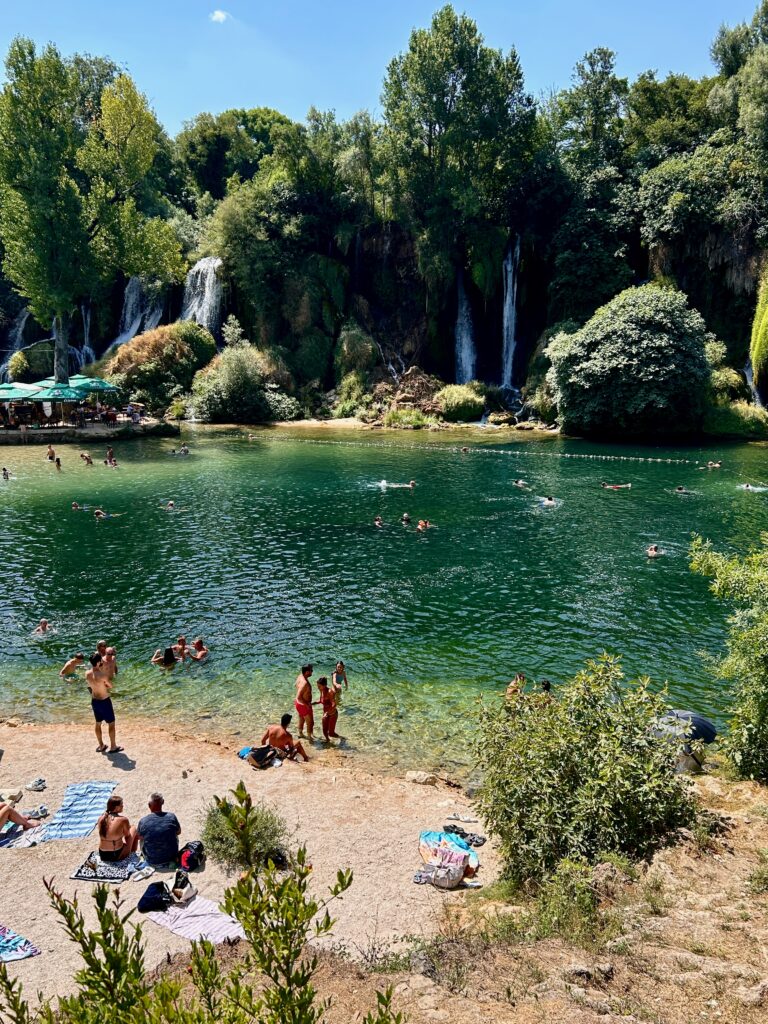
Kravica Waterfalls
The Kravice Waterfall is the number one attraction in the region surrounding Ljubuški. Its stunning cascade stretches over 100 meters wide and tumbles down 25 meters into a emerald green lake below. Surrounded by lush vegetation, it’s a paradise for nature lovers and photographers. Visitors can swim in the refreshing waters, picnic on the shores, or kayak for a closer look at the falls. The site is less crowded than many European waterfalls, offering a serene experience. As usual, avoid visiting between 11:00-15:00 to beat the crowds.
- entry is 10EUR per person
- it’s a 5-min hike to reach the main waterfall
- there are restaurants and shops all around
- large parking accessible free of charge
Koćuša Waterfall
- free entrance
- 2-3 restaurants around the waterfall
- large parkings accessible free of charge
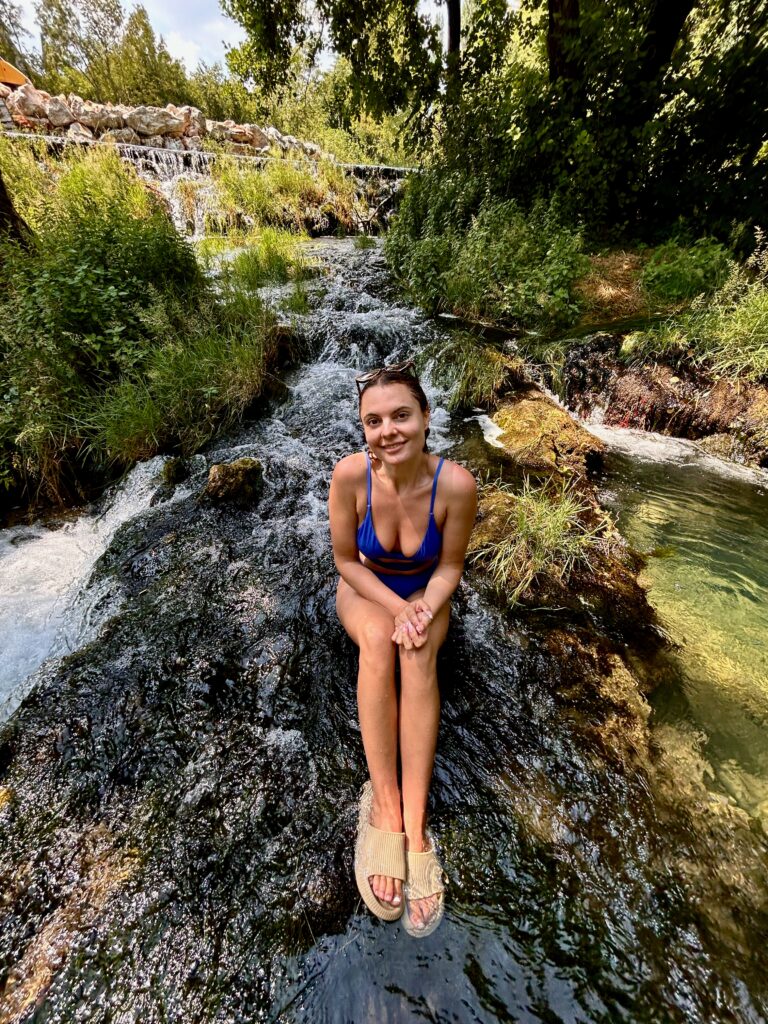
Day 8: Mostar (Bosnia and Herzegovina)
In Bosnia and Herzegovina, Mostar’s old town dates back to the middle ages and received its name from the bridge keepers, who were called “mostari” during the Ottoman period.
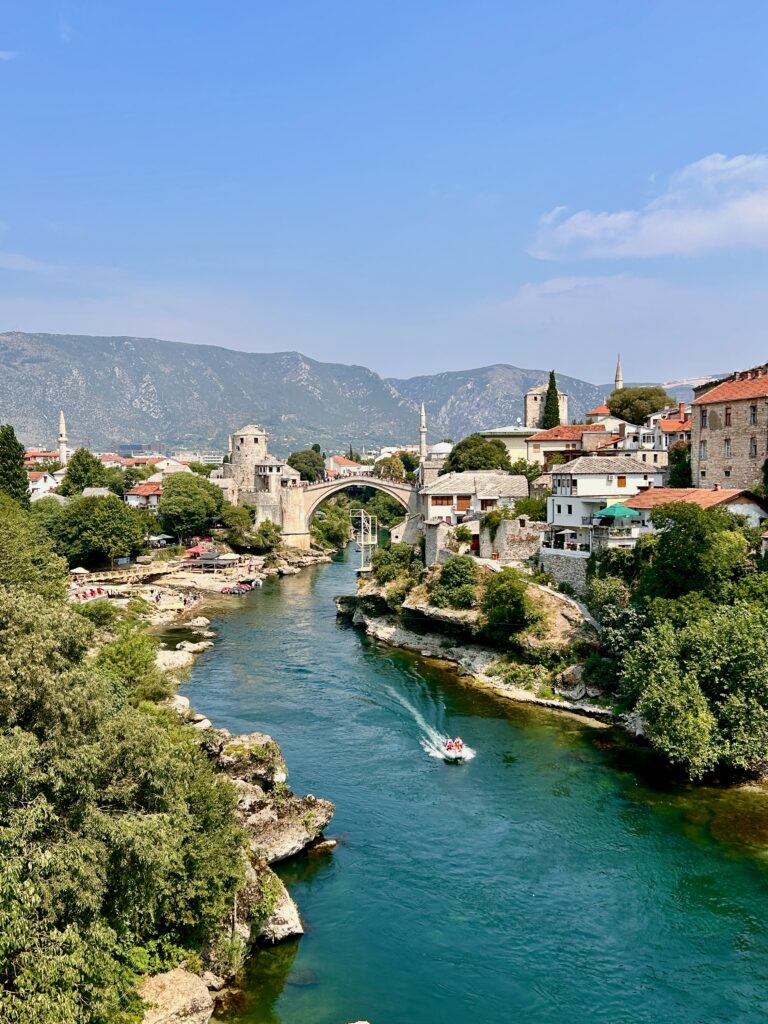
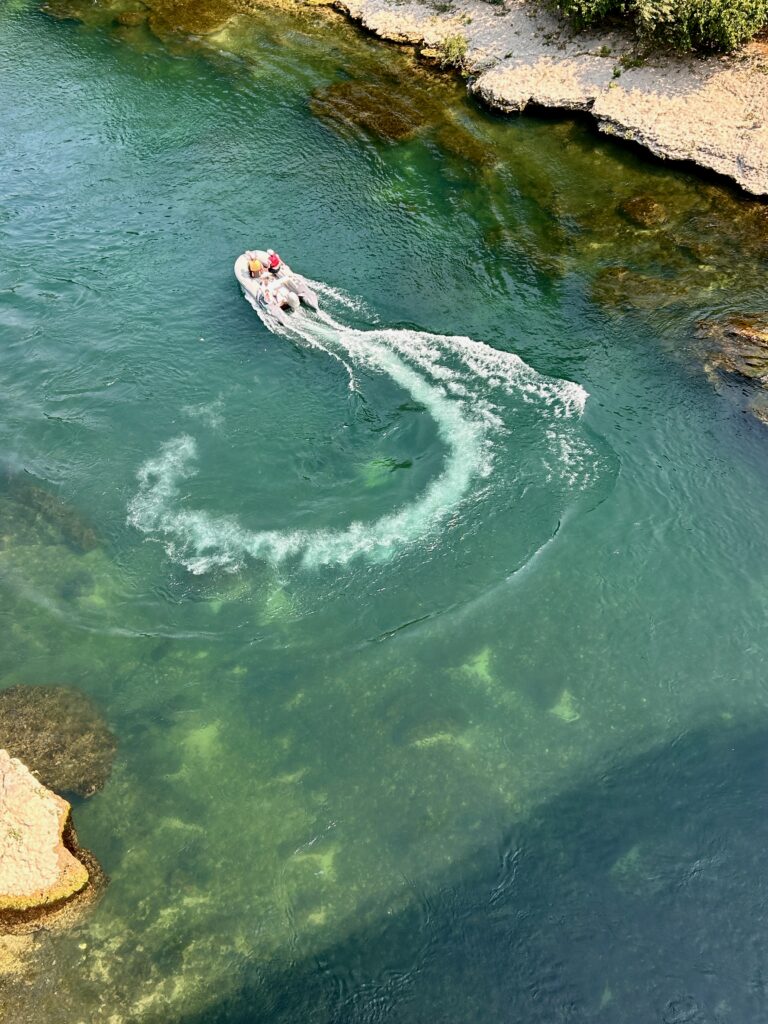
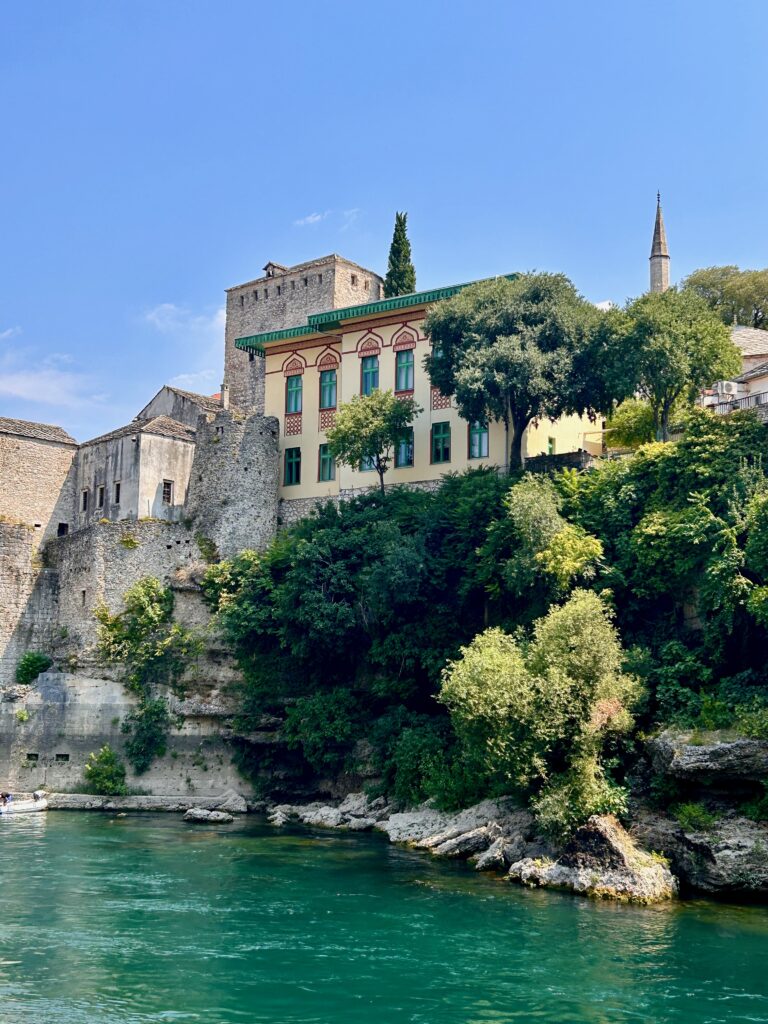
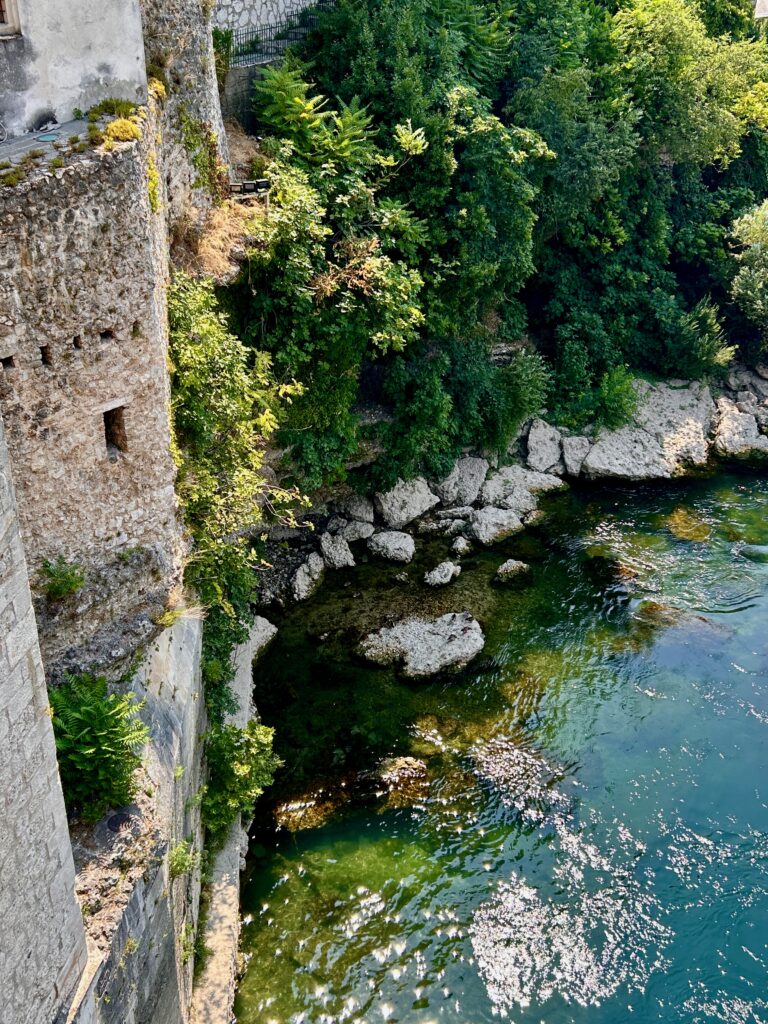
The old bridge of Mostar (stari most) was built in 1566 “like a rainbow arch soaring up to the skies, extending from one cliff to the other” in the words of the explorer Evliya Çelebi. It is one of UNESCO’s World Heritage Sites.
Mostar’s iconic bridge stood for 427 years before it was deliberately destroyed during the Bosnian War in 1993. What’s surprising is that when it was rebuilt in 2004, engineers used many of the same techniques employed by the original Ottoman builders. They even recovered stones from the original bridge from the river below and incorporated them into the new structure. The rebuilding process became a symbol of post-war reconciliation.
We loved walking through Mostar’s streets filled with merchants (and tourists), photographing wonderful views over the Neretva River, and listening to podcasts about the history of the Balkans while driving through its roads!
📎 my tip: arrive between 8:30-9:00 to avoid crowds and heat or around 19:00 for golden hour!
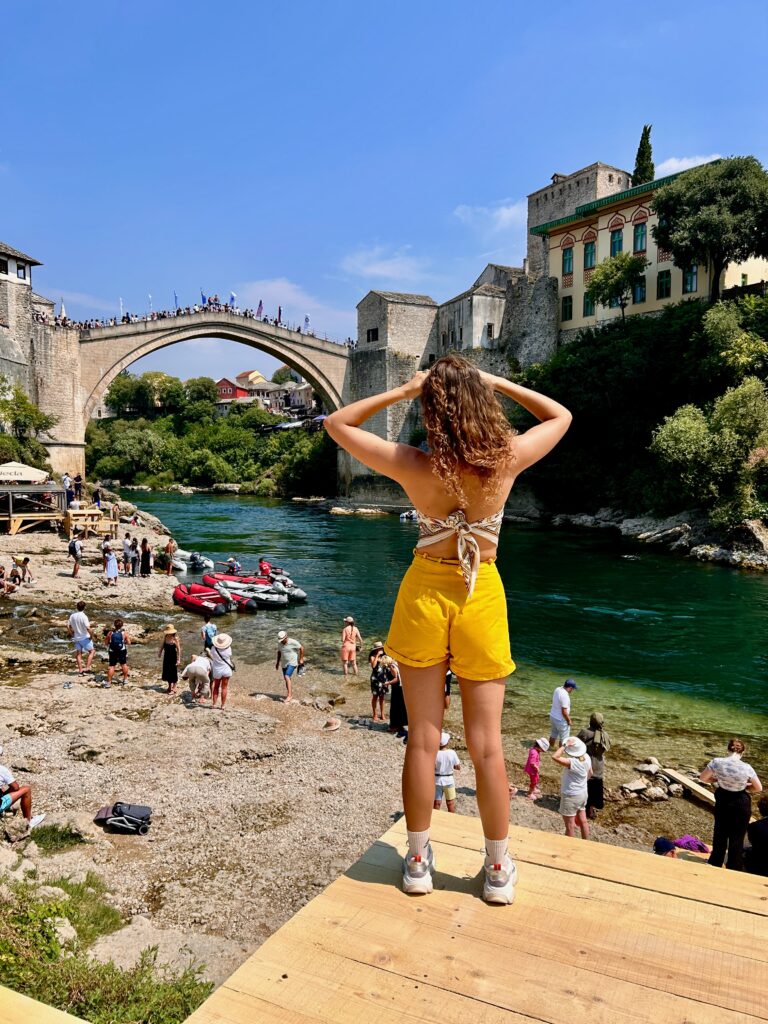
Day 9: Trsteno (Croatia)
Back into Croatia, we stopped by the village of Trsteno. It was one of the highlights of our road trip through the Balkans and I recommend anyone to stop there if they visit southern Croatia. Trsteno is famous for its old arboretum, a big garden with many exotic and local trees and plants. It was started by a noble family in the 15th century. It has tall palm trees and a pretty fountain with Neptune, the sea god. From there, you can see fantastic views of the Adriatic Sea.
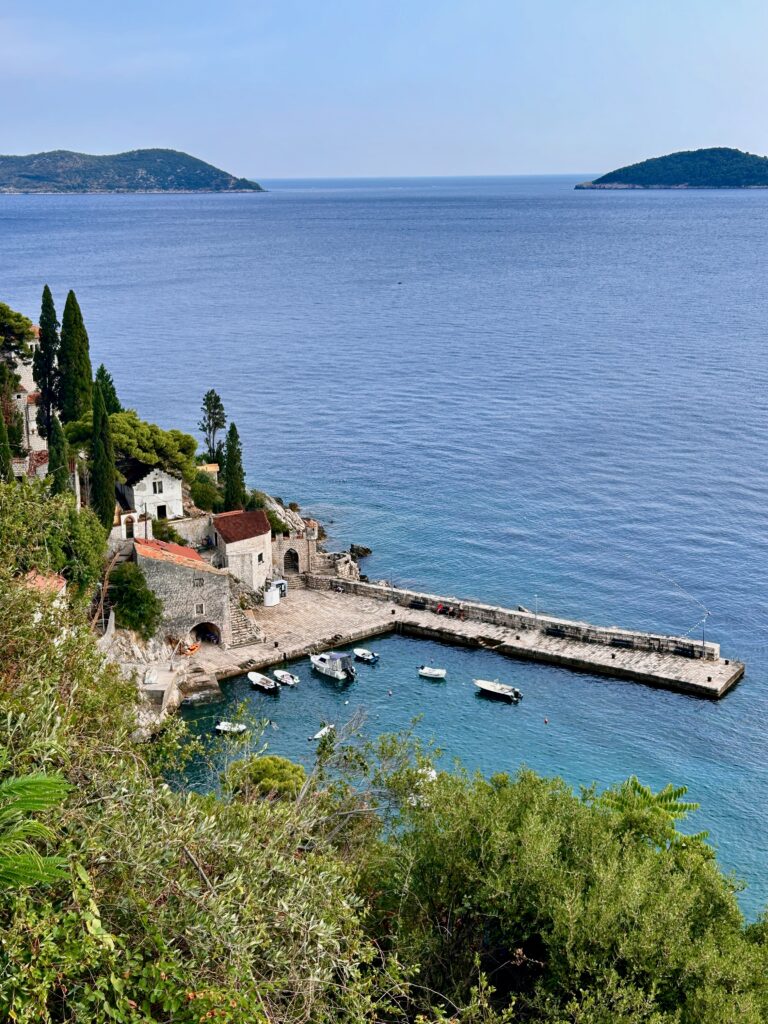
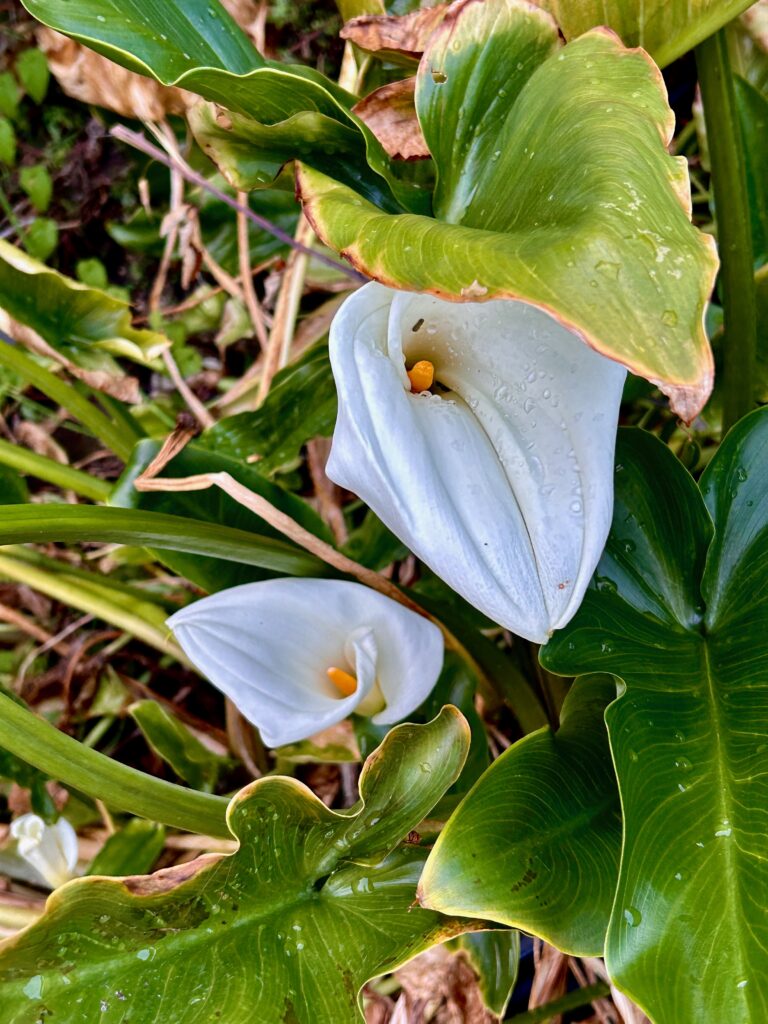
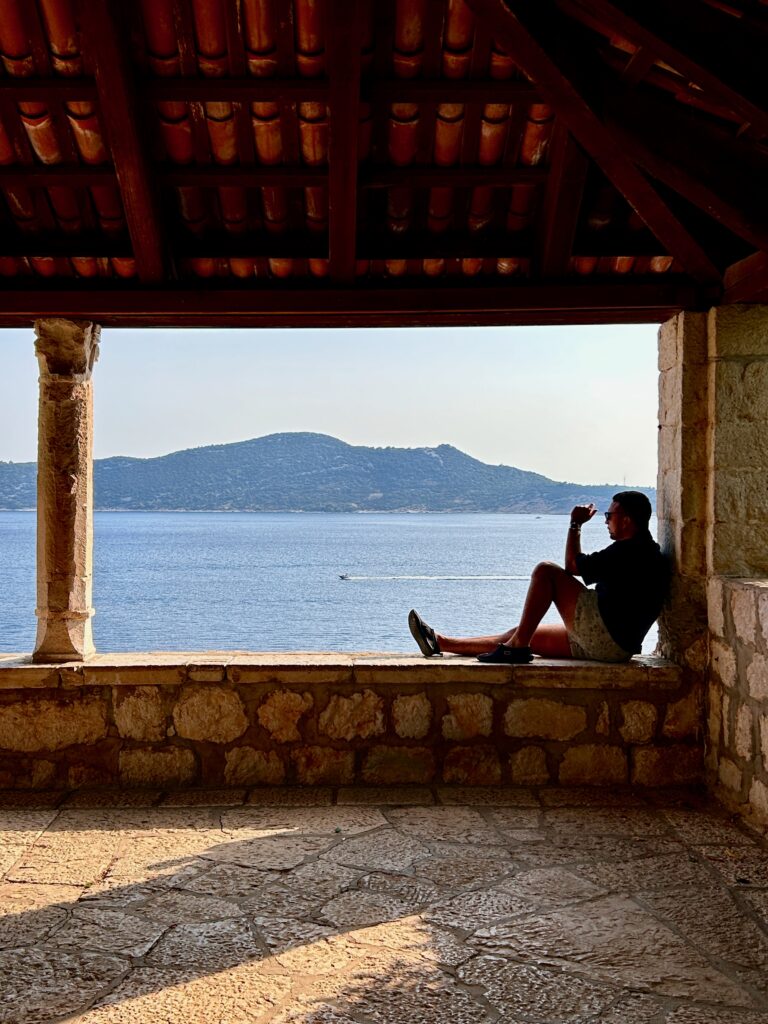
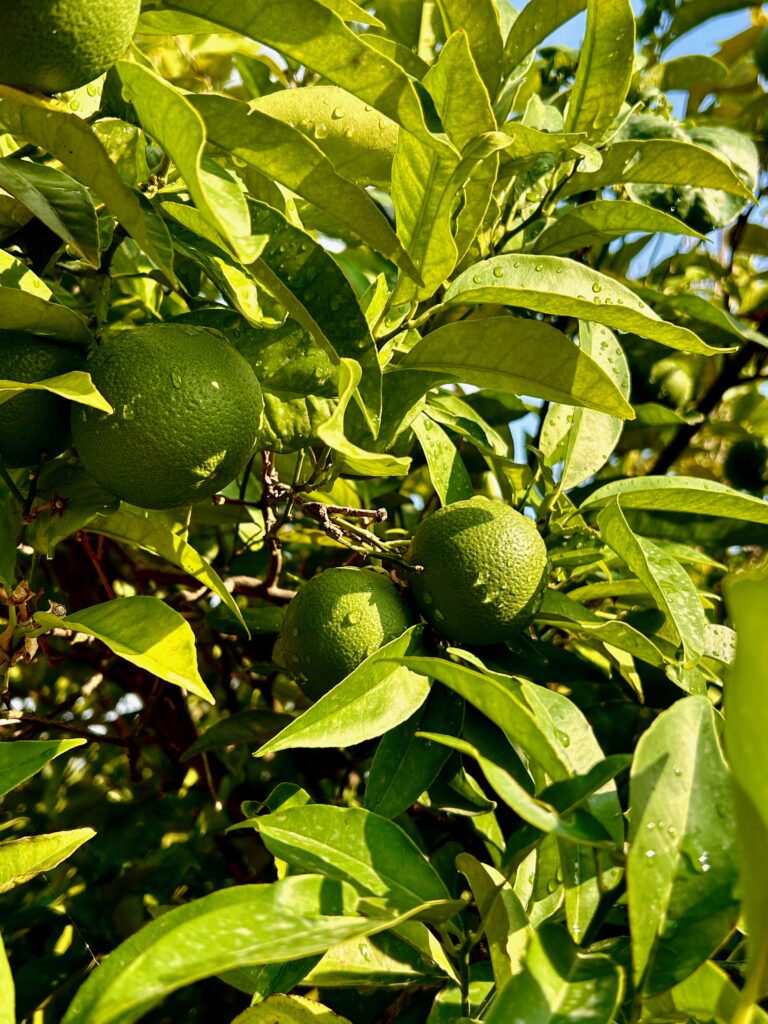
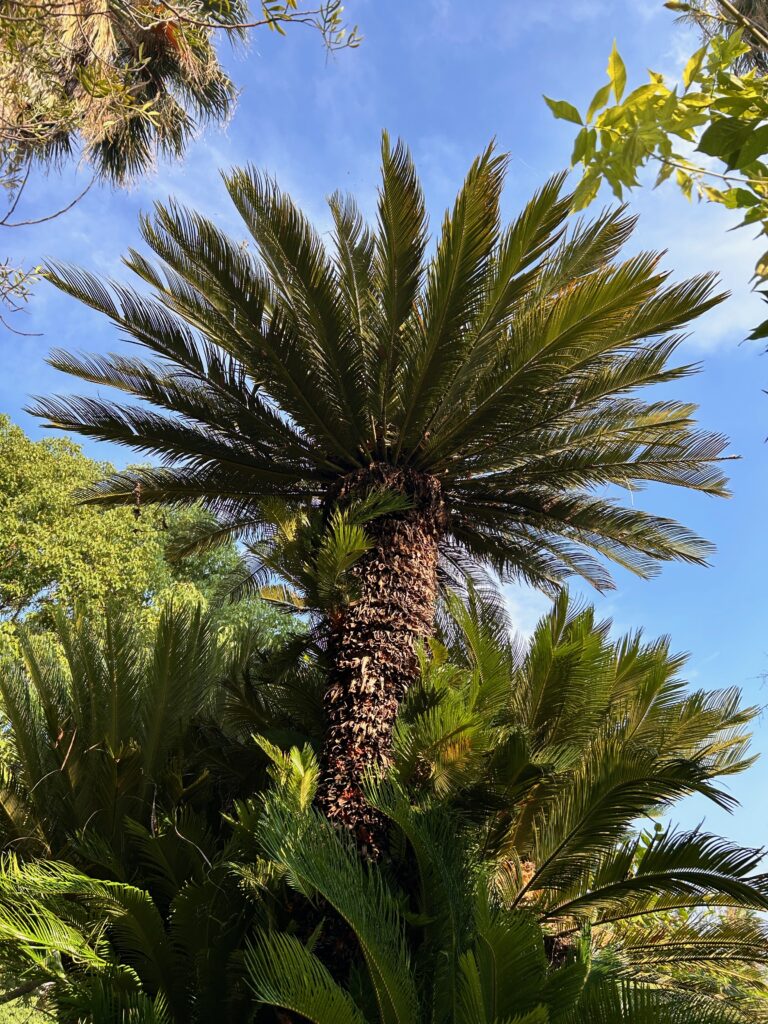
Trsteno also has a nice marina where you can swim, with a public shower and vending machine. All the way down, there is a pool of salt water carved into the rocks of the shore, an absolute wonder. The village is quiet and peaceful, making it a good break from busy Dubrovnik. There are however no restaurant within walking distance, so make sure to have snacks and sandwiches with you!
We stayed in a lovely room at Radovčić Apartments, which was located in the top part of the village, secluded in between alleyways filled with flowers. Parking was difficult but we got lucky and found a spot right next to our entrance.
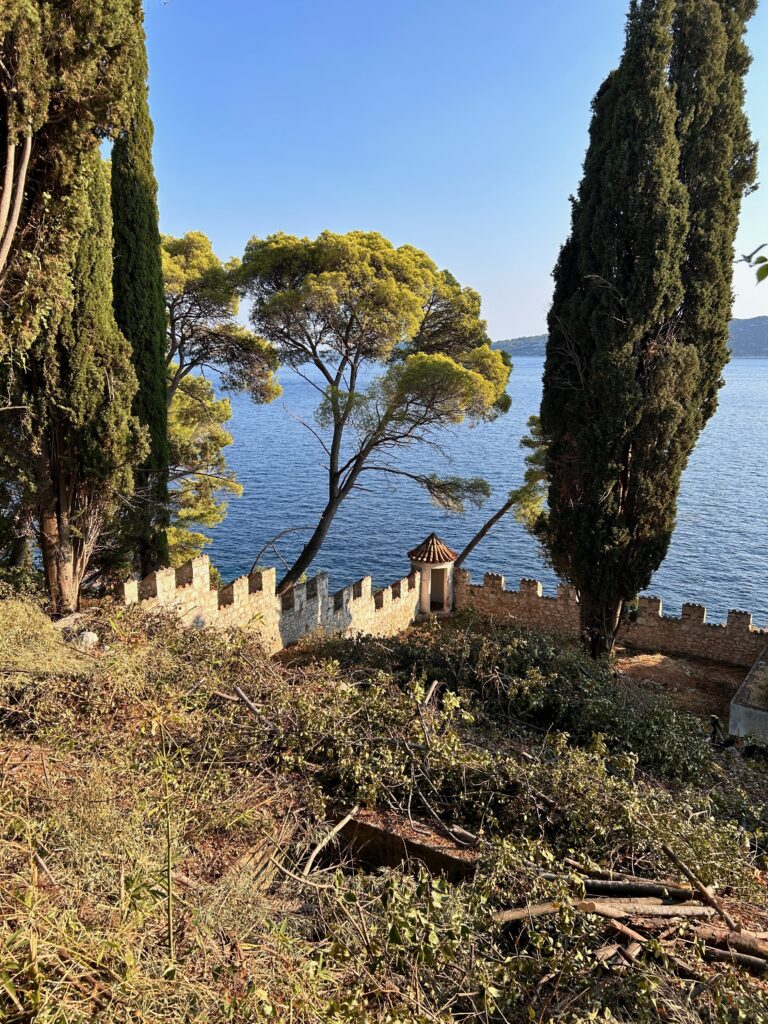
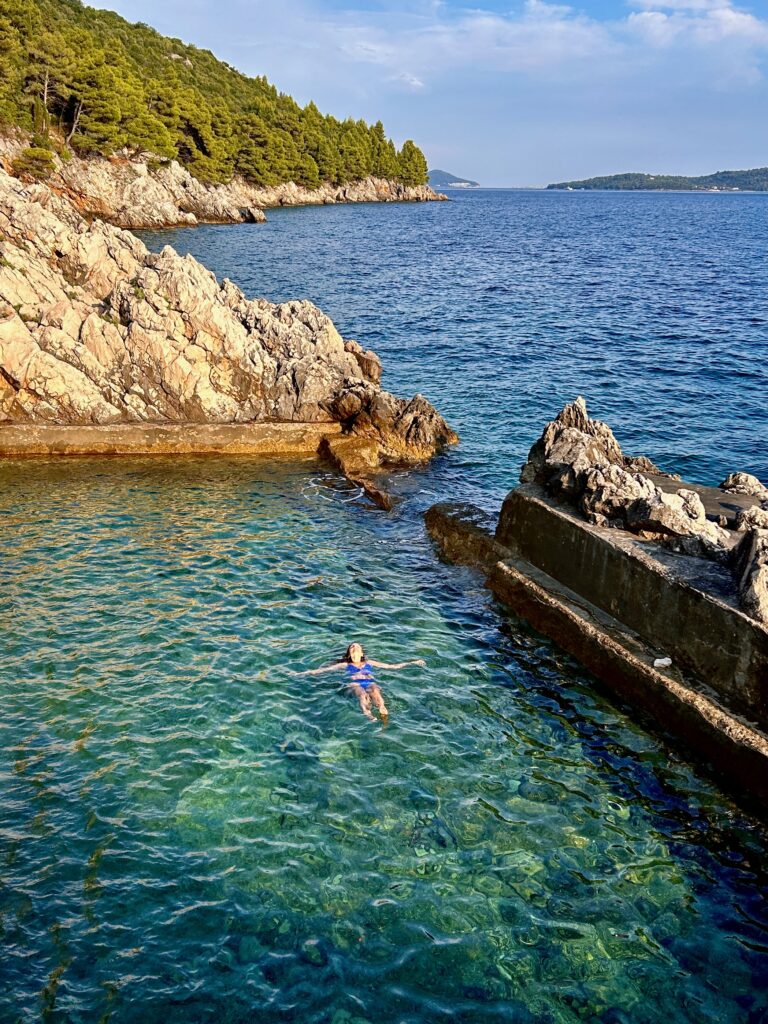
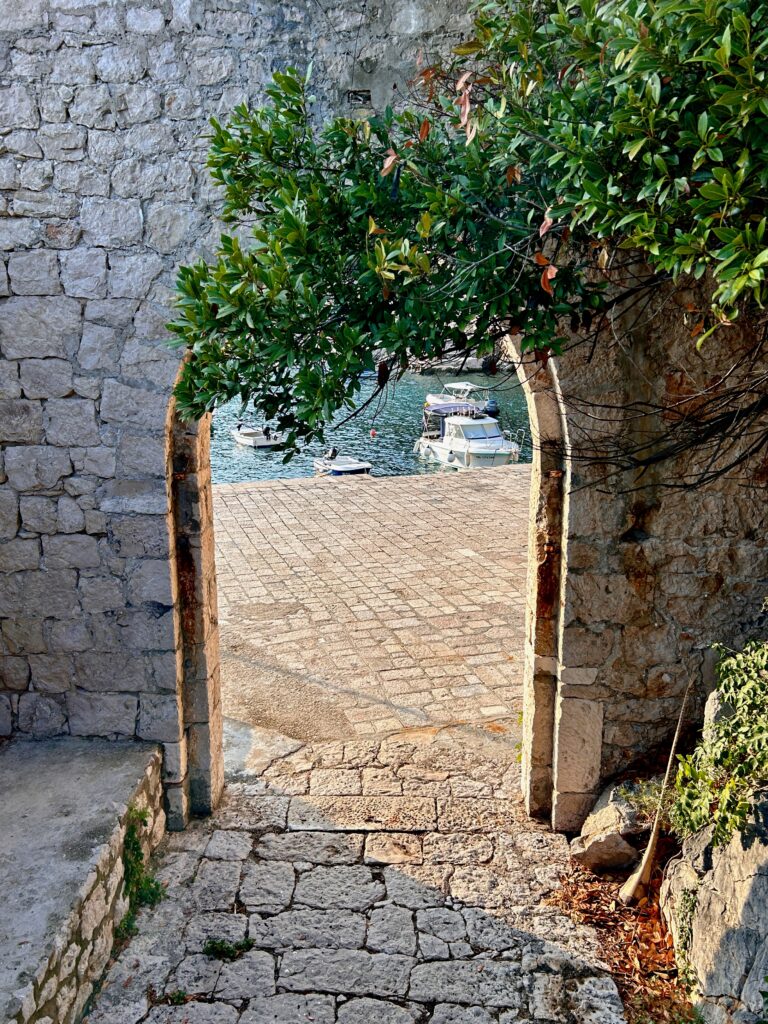
Day 10: Dubrovnik (Croatia)
Dubrovnik, often referred to as the “Pearl of the Adriatic,” has a history stretching back to the 7th century. Once known as Ragusa, this city was a thriving maritime republic, and its well-preserved medieval architecture reflects its storied past. The Old City of Dubrovnik, a UNESCO World Heritage Site, is encircled by impressive stone walls dating from the 11th to 17th centuries. Walking along these walls offers sweeping views of the Adriatic Sea and the city’s iconic red-tiled rooftops. This experience is essential for any visitor, as it provides a unique glimpse into the city’s layout and history.
We recommend heading to the city walls at their opening – 8:30am – to have the best experience with few people, a quiet city, and beautiful light. You can purchase tickets beforehand for 35EUR per person. For the same price, you can also purchase the Dubrovnik Day Pass (here), which includes entry to the city walls, most of the museums, and unlimited public transport – which is what we opted for.
Key sites to explore include the Rector’s Palace, showcasing Dubrovnik’s political heritage, and the 15th-century Sponza Palace, which now houses the city archives. The baroque St. Blaise’s Church and the Franciscan Monastery, home to one of Europe’s oldest operating pharmacies, are also worth visiting. For a relaxing break, take the cable car up Mount Srđ for panoramic views, or visit Banje Beach just outside the city walls. As you wander through Dubrovnik’s narrow streets, you can savor local dishes at cozy restaurants and soak in the vibrant atmosphere of this magnificent historic city!
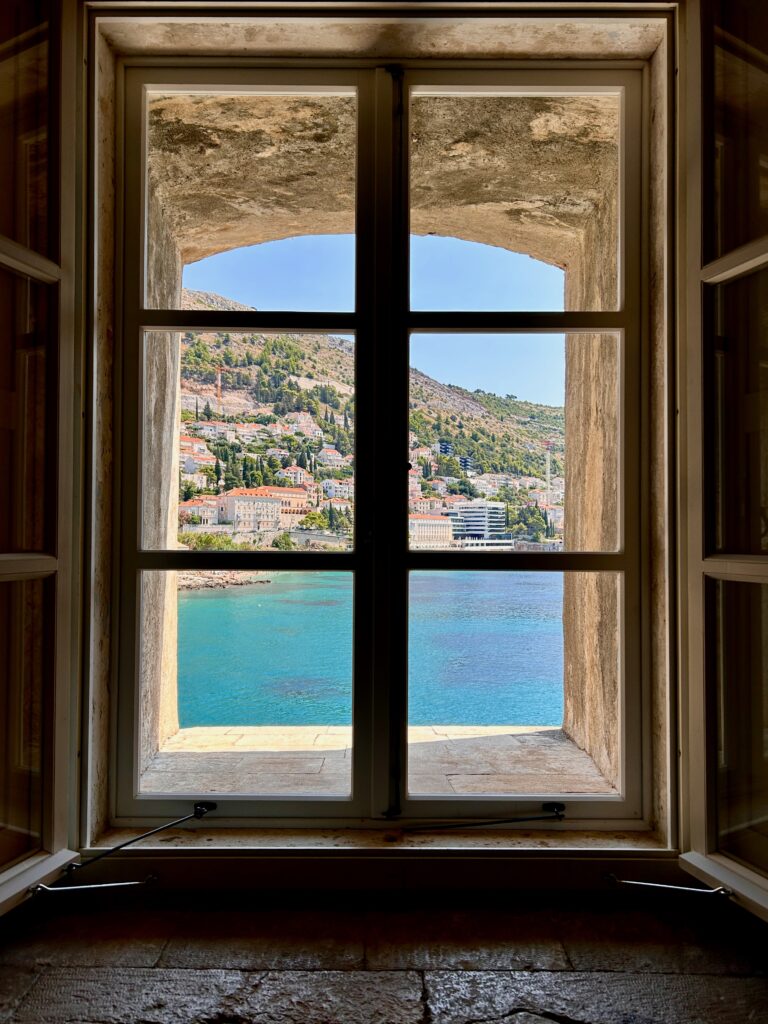
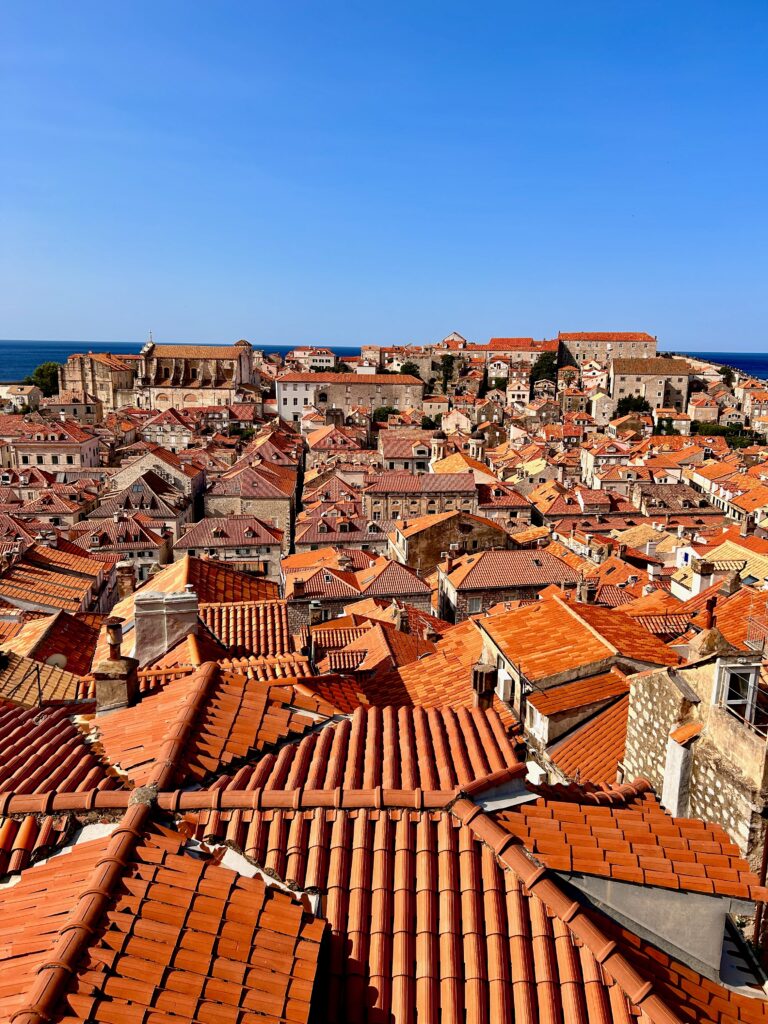
After Dubrovnik, we crossed the border to Montenegro, which took 7 hours in total before we reached our next destination. I recommend leaving early or late and having a good playlist or podcast to listen to! We love listening to Everything Everywhere Daily, which has hundreds of episodes covering general culture and history, including about one introduction about the Balkans (episode here). I highly recommend it as an entertaining and educative resource.
Day 11: Bay of Kotor (Montenegro)
In Montenegro, our first destination was the Bay of Kotor, often called Boka Bay, a breathtaking site on Montenegro’s Adriatic coast. The Bay of Kotor is surrounded by steep mountains and charming historical towns, which landed it the title of UNESCO World Heritage Site.
Perast
We first stopped in the picturesque town of Perast, known for its elegant baroque architecture and stunning waterfront. Perast is home to the iconic Our Lady of the Rocks, a man-made island with a beautiful church and museum. A boat ride to this island offers a unique perspective of the bay. We stayed at Admiral Apartments, which had fantastic views and great comfort. We loved our romantic dinner at Trattoria Rosmarino.
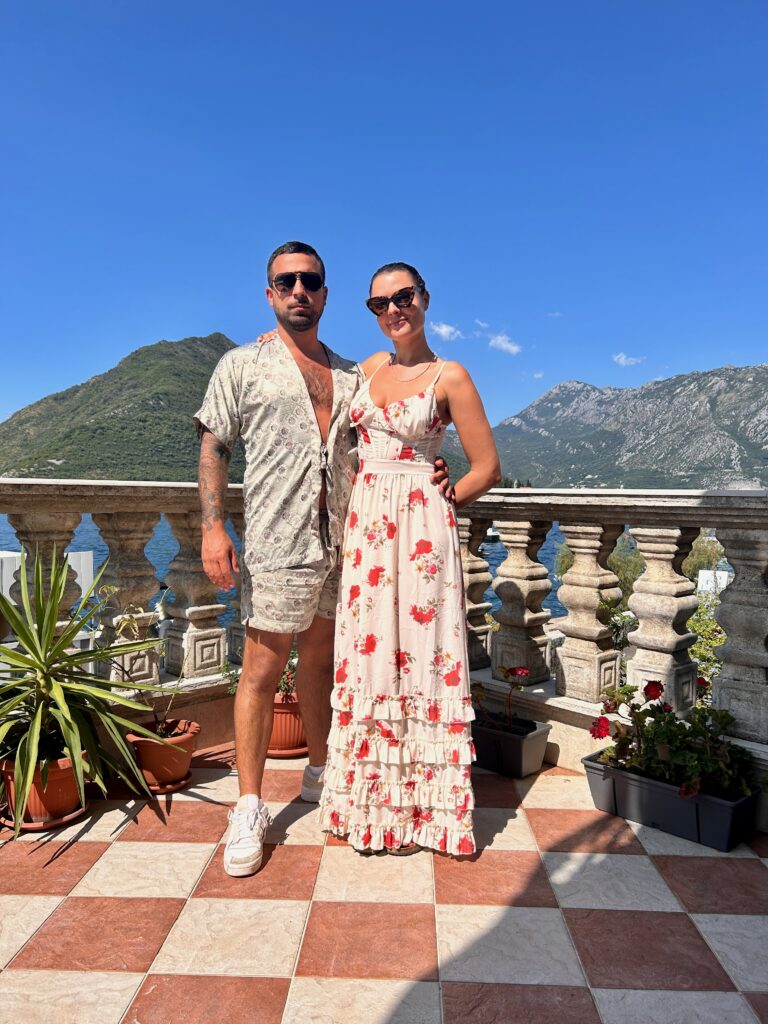
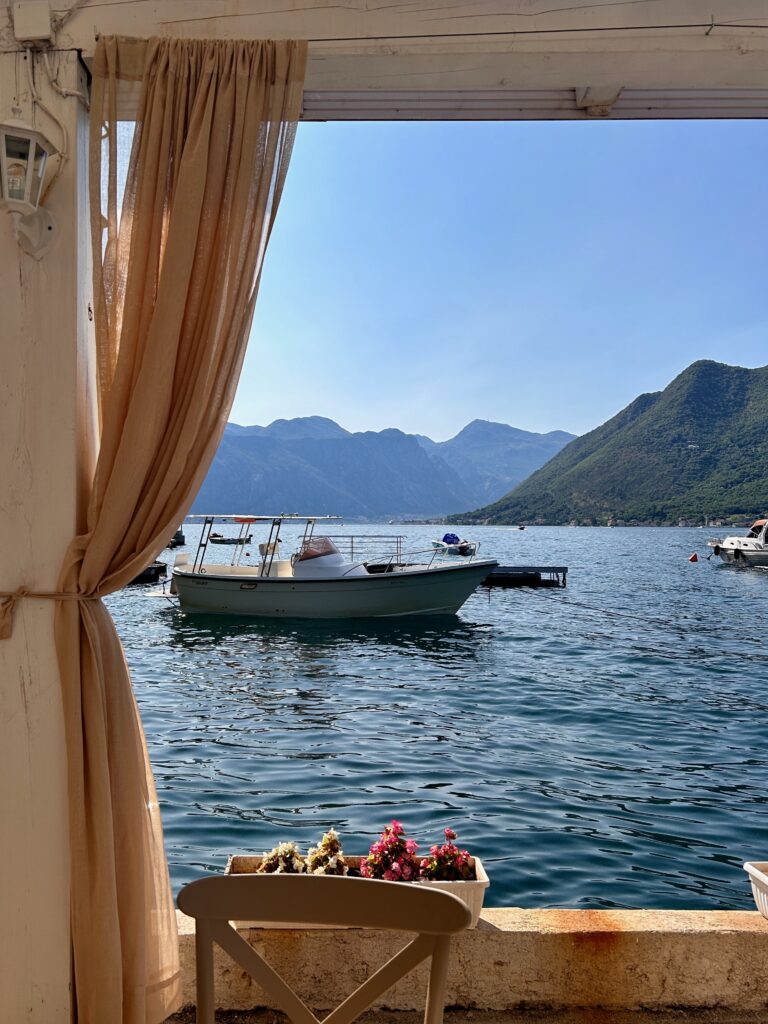
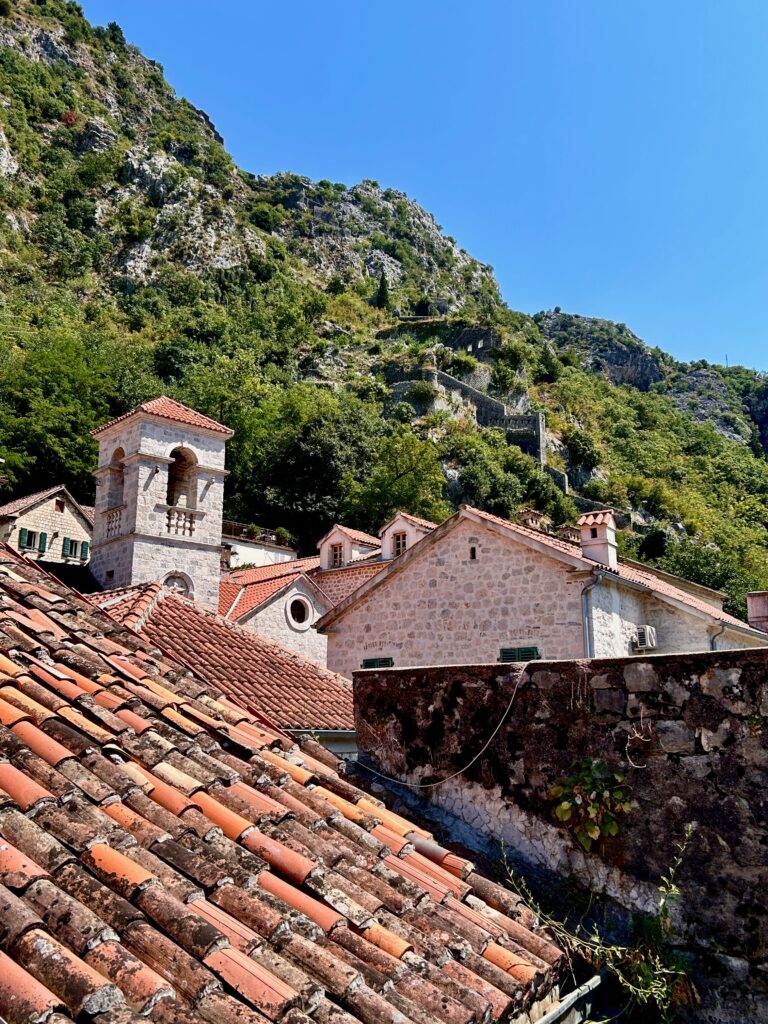
Kotor
Kotor, the bay’s most famous town, is a well-preserved medieval city with roots tracing back to the Roman era. The Old Town is a maze of narrow streets, stone buildings, and historic churches, including the impressive St. Tryphon’s Cathedral. A hike up the ancient city walls to the fortress of San Giovanni rewards you with panoramic views of the bay and the surrounding mountains.
I recommend to explore the area’s vibrant markets, enjoy fresh seafood at local restaurants, and take a leisurely boat trip around the bay. We loved the local oysters shack of Školjke Boke. The blend of natural beauty and historical charm makes the Bay of Kotor a must-visit destination in Montenegro!
Day 12: Virpazar (Montenegro)
We stopped by the town of Virpazar in Montenegro, the gateway to one of the country’s most enchanting natural regions of the Balkans. This small, picturesque village is surrounded by lush hills and is steeped in history, making it an ideal base for exploring the stunning landscapes and rich culture of Lake Skadar.
Lake Skadar, the largest lake in the Balkans, is a protected national park renowned for its diverse wildlife, particularly its vibrant birdlife, including rare species like the Dalmatian pelican. A boat tour from Virpazar is a must, allowing visitors to glide through the lake’s serene waters, past lily-covered bays, and ancient monasteries perched on tiny islets. We recommend booking with Golden Fish, which is a local family-run business. We had a wonderful experience with them. It was so beautiful that I literally cried! I recommend going towards the end of the afternoon for the best experience.
In Virpazar itself, there is not much to do, but we recommend exploring the many restaurants of the region, which is famous for its wine. We had some of the most delicious dishes in Virpazar, for the cheapest prices. We tested and approved Pelikan, a local institution in the heart of Virpazar, and Obala, a small hidden gem next to the river across the bridge.
For the more adventurous, the surrounding region offers excellent hiking opportunities, with trails leading through verdant forests, traditional villages, and scenic viewpoints. Whether you’re a nature lover or a history enthusiast, Virpazar and the Lake Skadar region provide a perfect blend of tranquility and exploration.
Day 13-15: Ulcinj (Montenegro)
We spent a few days in Ulcinj, Montenegro, to relax. We stayed at Stanaj Apartments which was absolutely beautiful and practically located within walking distance of tons of restaurants and shops. The beach of Ulcinj is very long and we came there to explore kitesurfing spots, which were between 10-20 min by car. There is quite a lot of traffic in this town, so avoid rush hours at all costs! We loved the nearby restaurant of Lovac, a true gem in the area, full of history and charm with the most delicious cuisine.
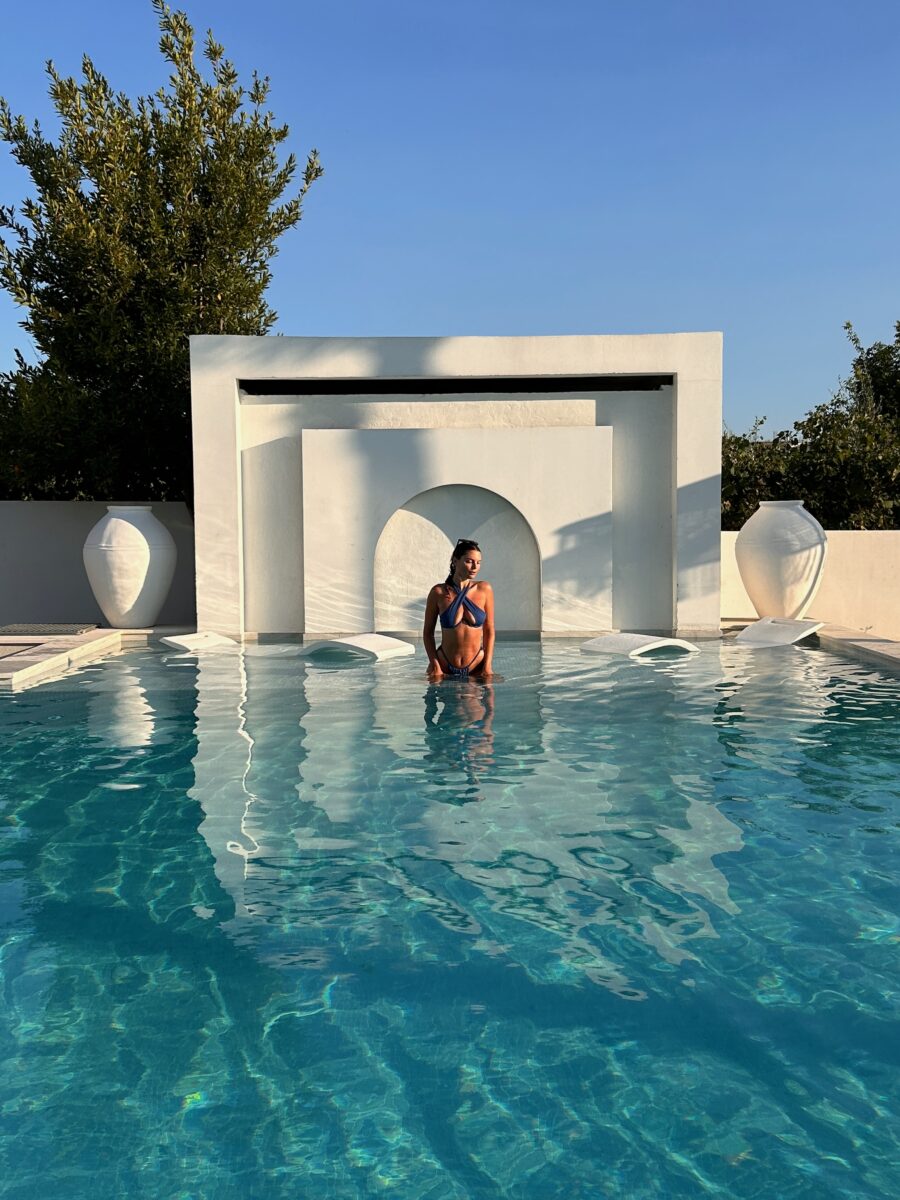
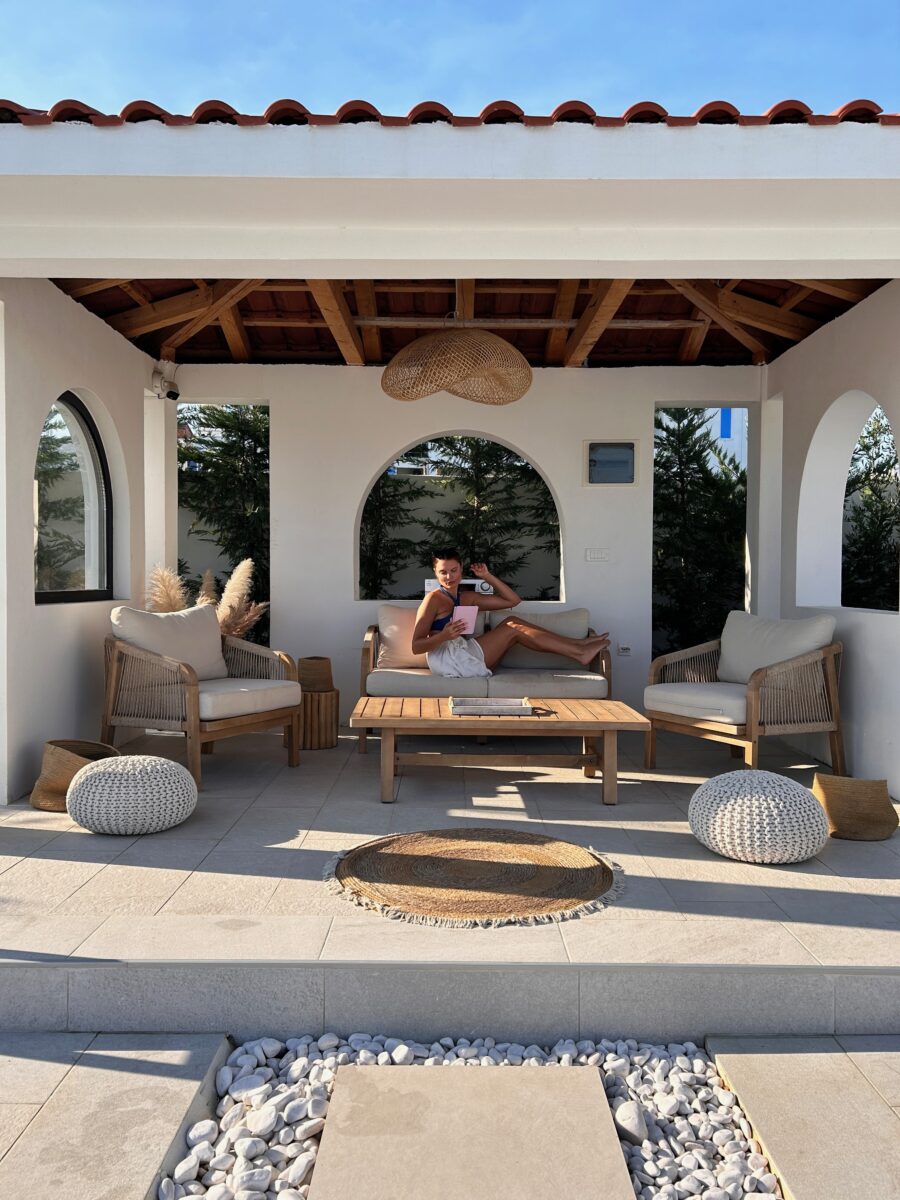
In Ulcinj, we mostly were lazy and enjoyed time sleeping at the beach or by the pool, listening to music, and resting. It was the perfect break half-way through our road trip of the Balkans but feel free to skip it or shorten your stay in Ulcinj if you are under a tight schedule or want to explore more culturally-rich towns. Ulcinj is famous for its beaches and parties! We loved it either way and enjoyed the attractions around.
Subscribe
for a monthly round-up of the latest advances in technology and global affairs, tips to thrive in academia, resources to support your personal growth, and more!
Day 16-17: Shkodër County (Albania)
Shkodër
First, we stopped by the Rozafa Castle near Shkodër. Perched on a hilltop, it stands is a symbol of the region’s rich history and legend. Dating back to antiquity, the castle has seen Illyrian, Roman, and Ottoman rule, each leaving its mark on the fortress. Visitors can explore the well-preserved walls and towers, offering stunning views of the surrounding rivers and mountains. The on-site museum provides insights into the castle’s past. Legend says the castle was built with the sacrifice of women, adding a mystical element to this historic site. A visit to Rozafa Castle is a must-see to start a journey into Albania’s ancient past.
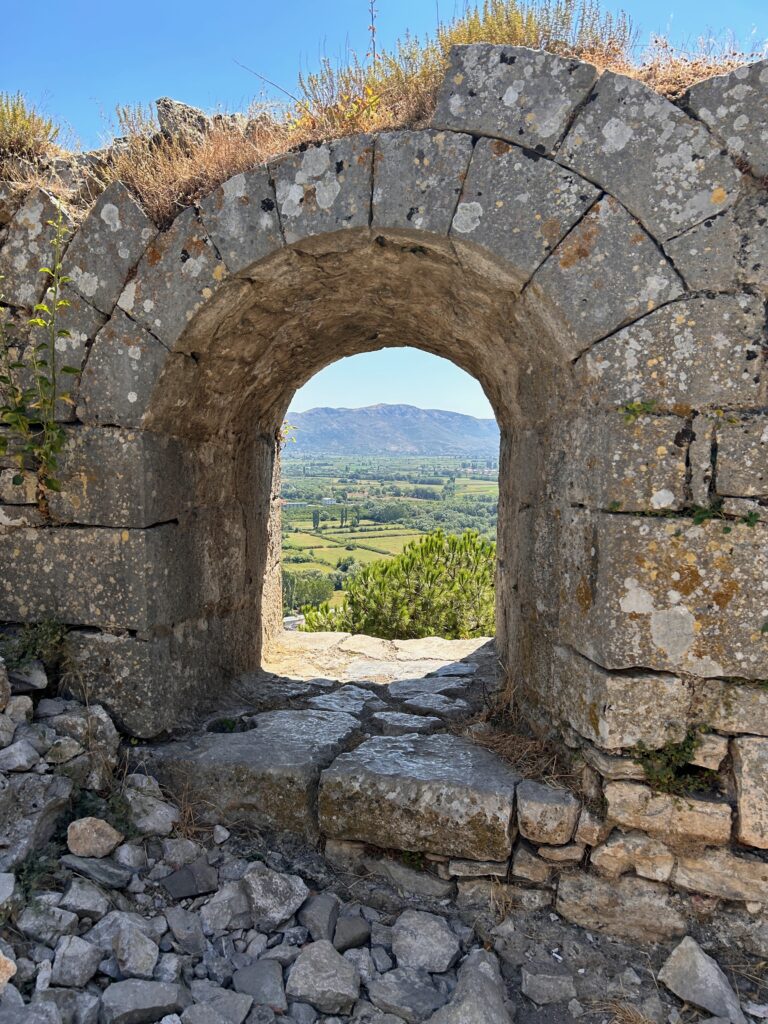
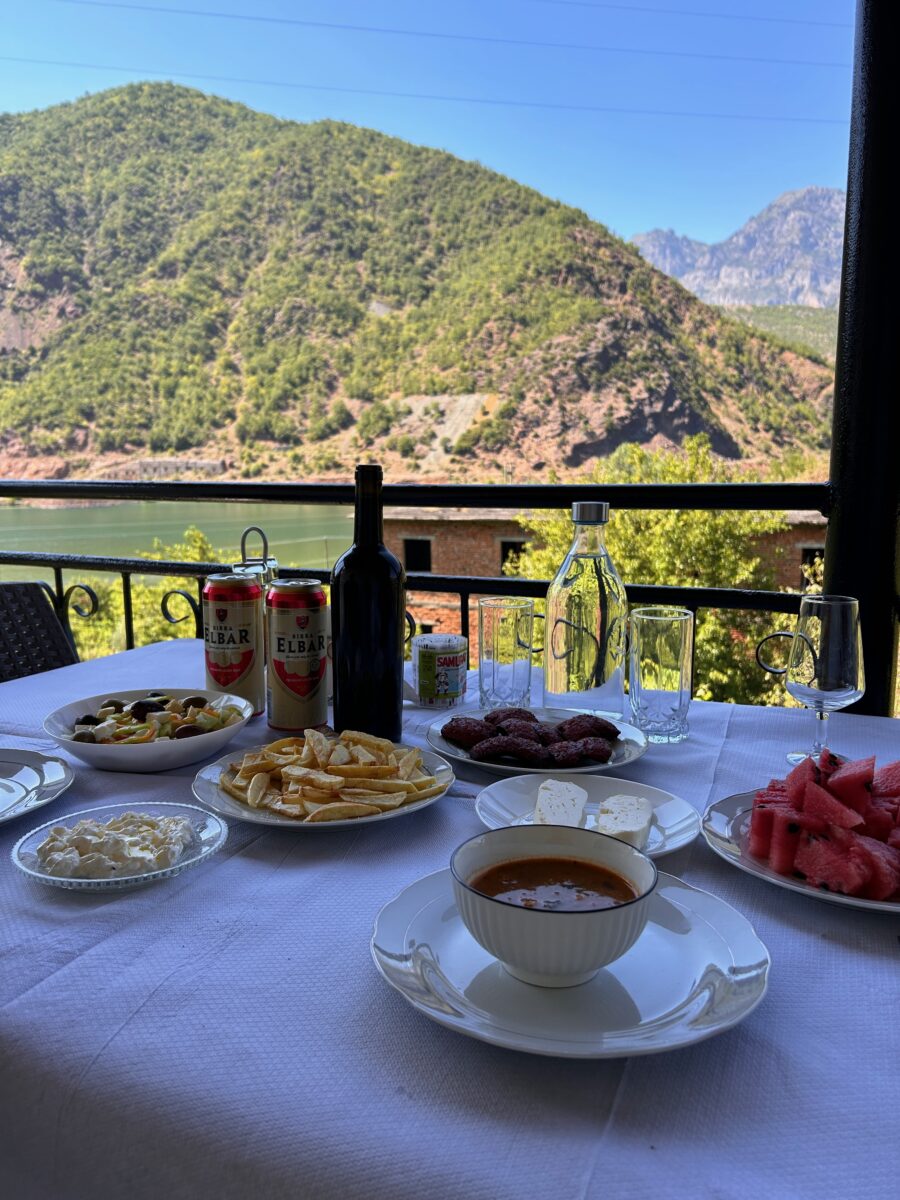
Koman
We then went onto an adventure through the County of Shkodër and the Lake of Koman, which is in a very isolated region of the Northern Albanian Alps. There, we found the most captivating views reminding us of the Norwegian fjords and the islands of Thailand. It was absolutely breathtaking!
From Shkodër, it takes approximately two hours to reach Koman, half of which is on a poorly done road, so I’d advise to go slow or get an SUV if that’s possible. Avoid driving at night and plan at least one night in Koman to recover… trust me on that!
In Koman, we stayed two nights at the most authentic bed and breakfast run by a couple of Albanian grandparents who cooked and welcomed us like family within their house: Docaj B&B. They used locally sourced ingredients and prepared the most delicious dishes, with impressive views of the mountain and the lake. It was honestly dreamy! I was truly moved by this experience.
Shala River
The must-do adventure when in Koman is to take a boat tour of the lake all the way to the river Shala. For 25EUR per person (book here), you get a tour departing from Koman at 9:00am, dropping you at the River Shala around 10:00am, and bringing you back to Koman around 15:00. Make sure to arrive at the departure point with plenty of time in advance – it was a bit chaotic and very difficult to find parking but the company kindly waited for us to arrive although we were late.
This was the perfect tour for us as we enjoyed the beautiful views of the lake and had plenty of time to explore the riverside. The turquoise waters were among some of the most beautiful I have seen – although they are very cold, you get used to it and it’s particularly refreshing when the temperatures get above 35 degrees Celsius! My advice is to walk as far as possible from the drop-off point to find more natural and quiet areas, as it gets quite busy at the area where boats drop you off. The good news is that there are plenty of restaurants and shops selling food, so you don’t need to worry if you forgot to bring something!
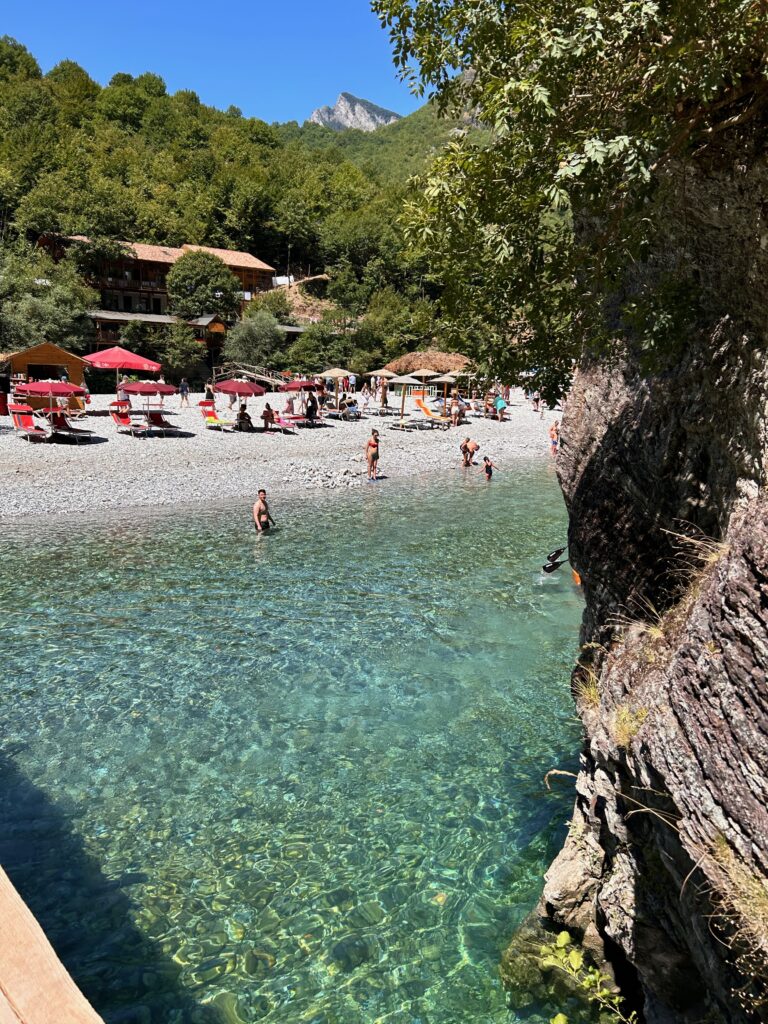
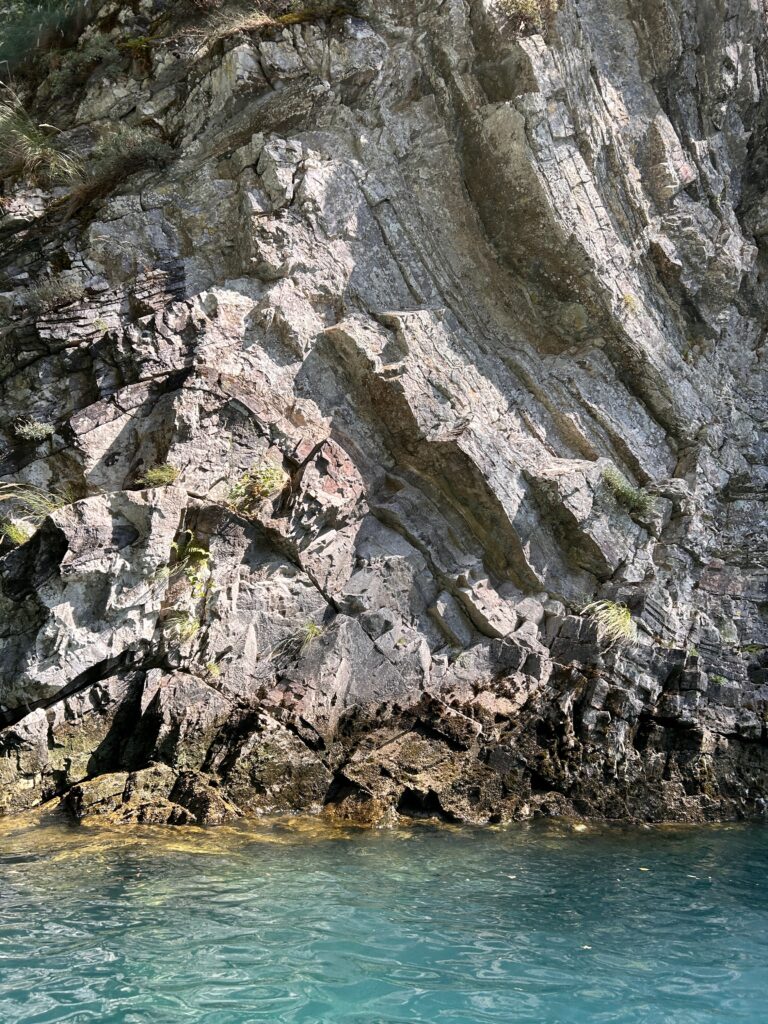
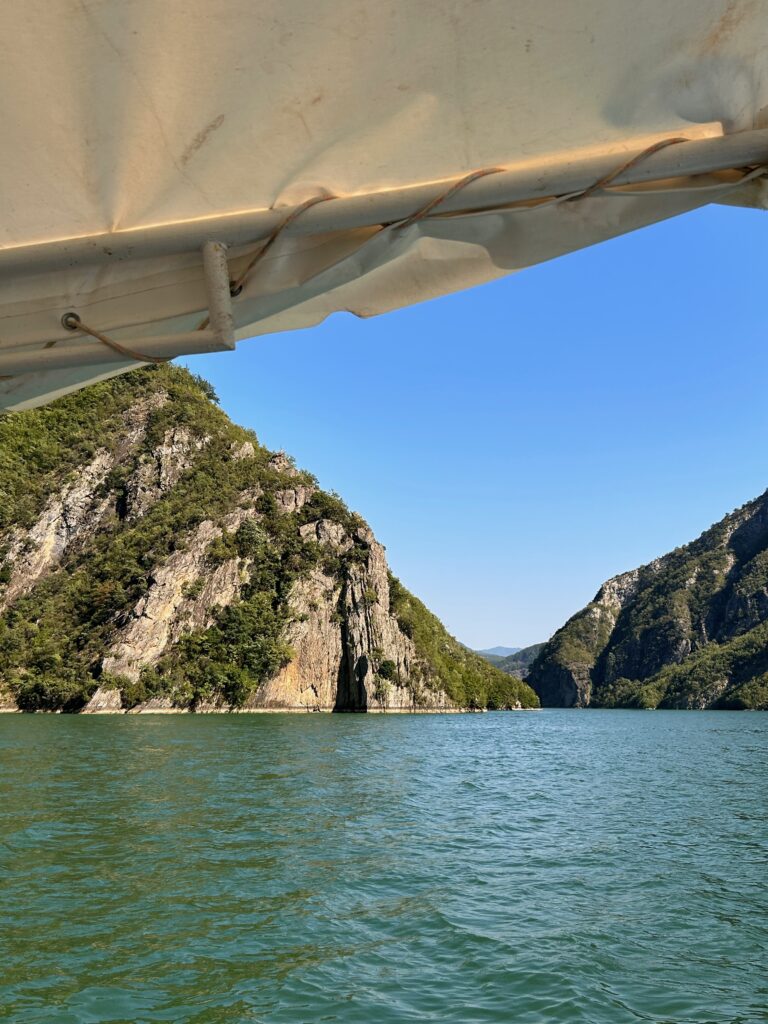
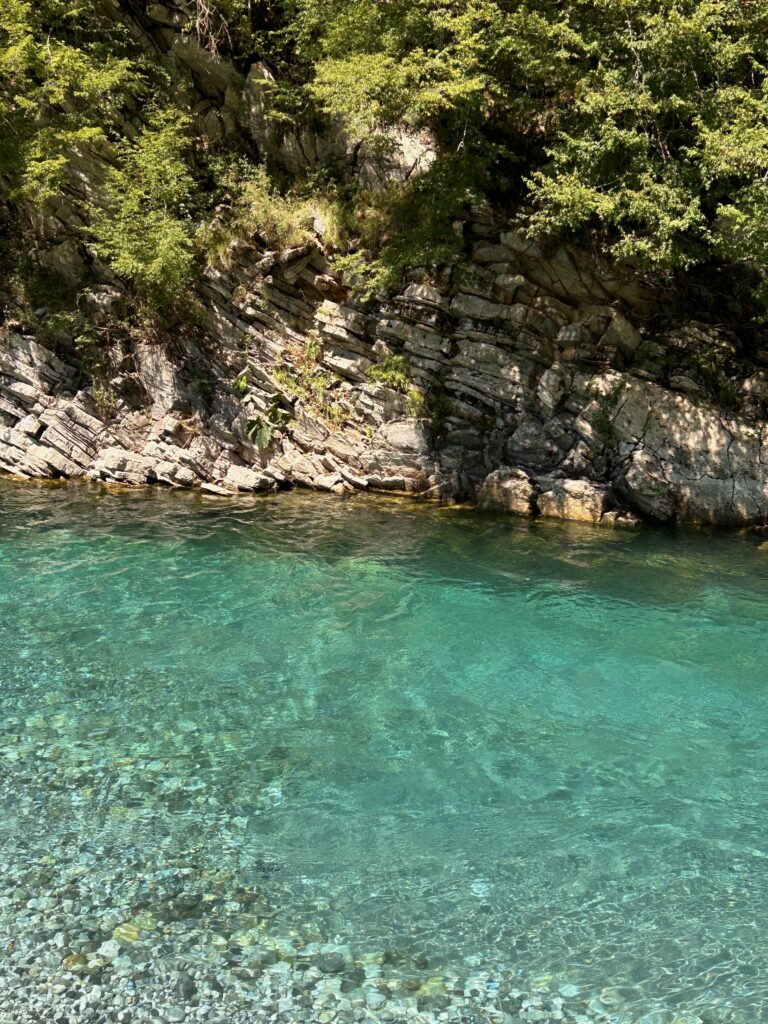
Day 18: Krujë (Albania)
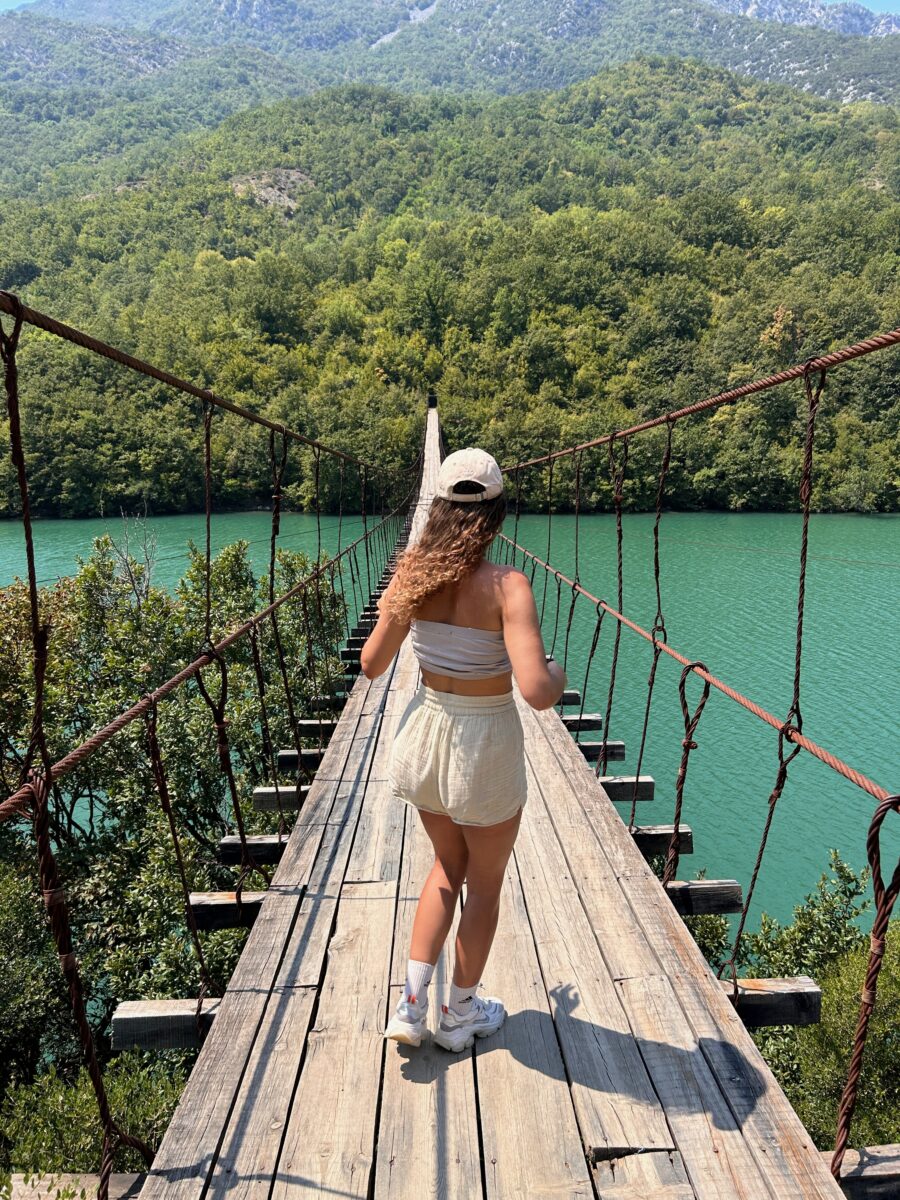
Our destination was Krujë, a historic town in central Albania perched on top of a hillside. It has a deep connection with the national hero, Gjergj Kastrioti Skanderbeg. On our way to Krujë, we stopped by Shkopet Bridge, famous for its impressive views and very scary crossing (which we did while holding our breaths lol).
The town’s centerpiece is the Krujë Castle, a well-preserved fortress that served as Skanderbeg’s headquarters during his resistance against the Ottoman Empire in the 15th century. Within the castle walls, the Skanderbeg Museum offers a fascinating look at his life and Albania’s struggle for independence. The Ethnographic Museum, housed in a traditional Ottoman-style house, provides insight into the daily life and customs of the region’s past.
Wandering through Krujë’s Old Bazaar, you will find yourself immersed in a charming marketplace that has remained largely unchanged for centuries. The cobblestone streets are lined with shops selling traditional Albanian crafts, including handwoven rugs, silver jewellery, and antiques including many artefacts from the Second World War. It’s a true living museum and a must-see for anyone fascinated by the history of the Balkans!
After exploring, take a moment to enjoy the panoramic views from the castle’s towers or visit the nearby Tekke of Dollma, a Bektashi religious site. We loved the rooftop views from our hotel, Mervin. It was also perfectly located near the centre and included a private parking. For dinner, we opted for Panorama Restaurant (part of the hotel of the same name), which we loved! It also had lovely views over the old city.
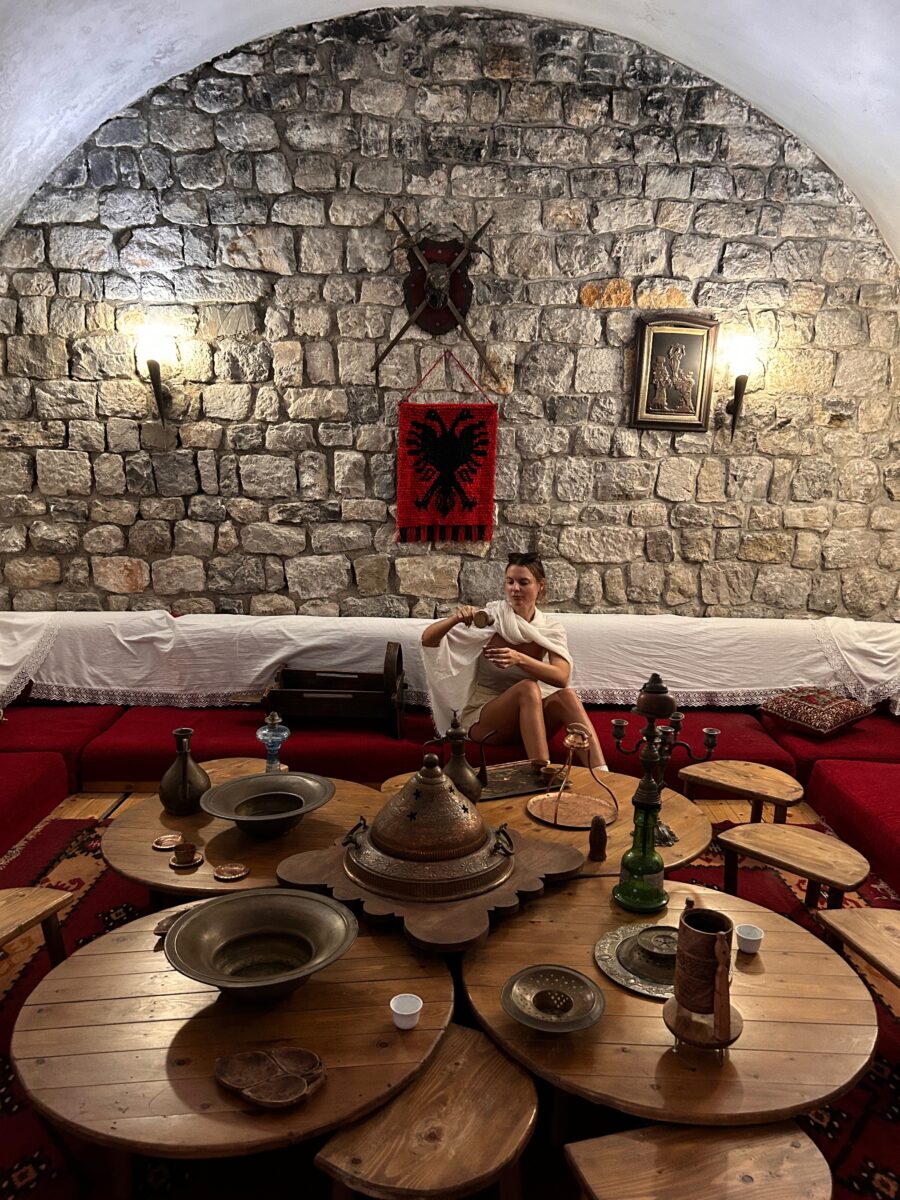
Day 19: Durrës (Albania)
For our last day in Albania, we wanted to completely relax on the coast of Durrës County, which offers a variety of atmospheres from busy sand beaches to quiet rocky creeks.
Durrës, Albania’s largest port city, is known for its vibrant coastline with lively bars, restaurants, and water sports. The main stretch, Plazhi i Durrësit, is perfect for sunbathing, with golden sands and warm waters.
For a more tranquil experience, we ventured to the nearby rocky coves of Cape Rodon, a short drive from the city. This area offers secluded spots ideal for a peaceful escape, with crystal-clear waters and picturesque views of the Adriatic Sea. We stopped by Sunset Bar, which had delicious milkshakes and iced coffees.
This was our last stop before heading to Tirana to return our car rental and fly back home!
Conclusion
In conclusion, our Balkans road trip was a mesmerizing journey that took us through four countries—Croatia, Bosnia and Herzegovina, Montenegro, and Albania—each offering its unique blend of culture, history, and natural beauty.
From the medieval streets of Dubrovnik to the serene waters of Lake Skadar, every destination on this 19-day adventure provided something special, whether it was exploring ancient fortresses, swimming in pristine waterfalls, or simply relaxing on sun-kissed beaches. The diversity of experiences, from bustling cities to tranquil villages, ensured that every day was filled with new discoveries and unforgettable moments. This road trip not only fulfilled our dreams of exploring the Balkans but also deepened our appreciation for this often-overlooked region and its diverse cultures.
Whether you’re seeking adventure, relaxation, or a deep dive into history, the Balkans offer a road trip experience that is as rich and rewarding as it is beautiful. If you’re looking for a journey that combines both iconic and hidden gems, this is the road trip of your dreams!
Itinerary
You can freely save, edit, and download the following itinerary on Google Maps. It includes all towns, cultural and historical sites, restaurants, hotels, waterfalls, and beaches mentioned in this article.
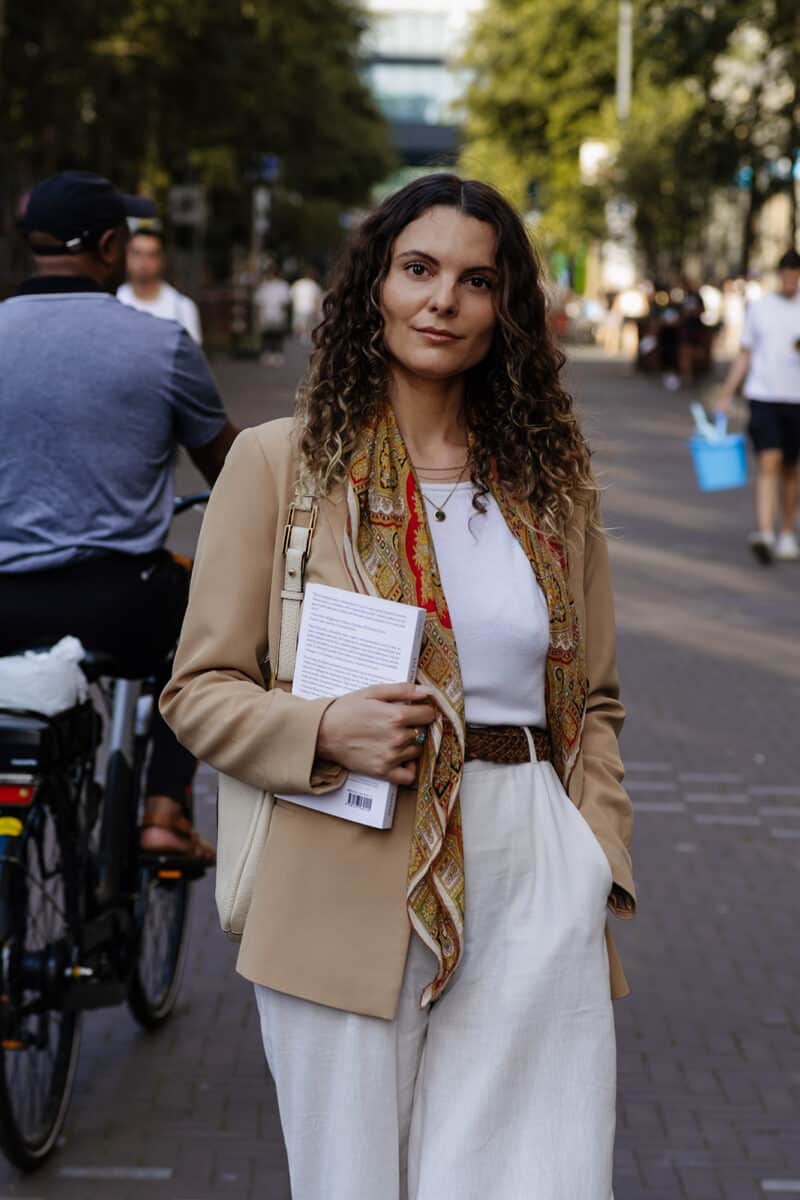
Hello! I’m Sophie
Explore my other travel guides...
I love creating unique itineraries and photographing the most beautiful scenes of my trips. I’ve created original guides for Mexico, Italy, Greece, Morocco, and the Balkans.


